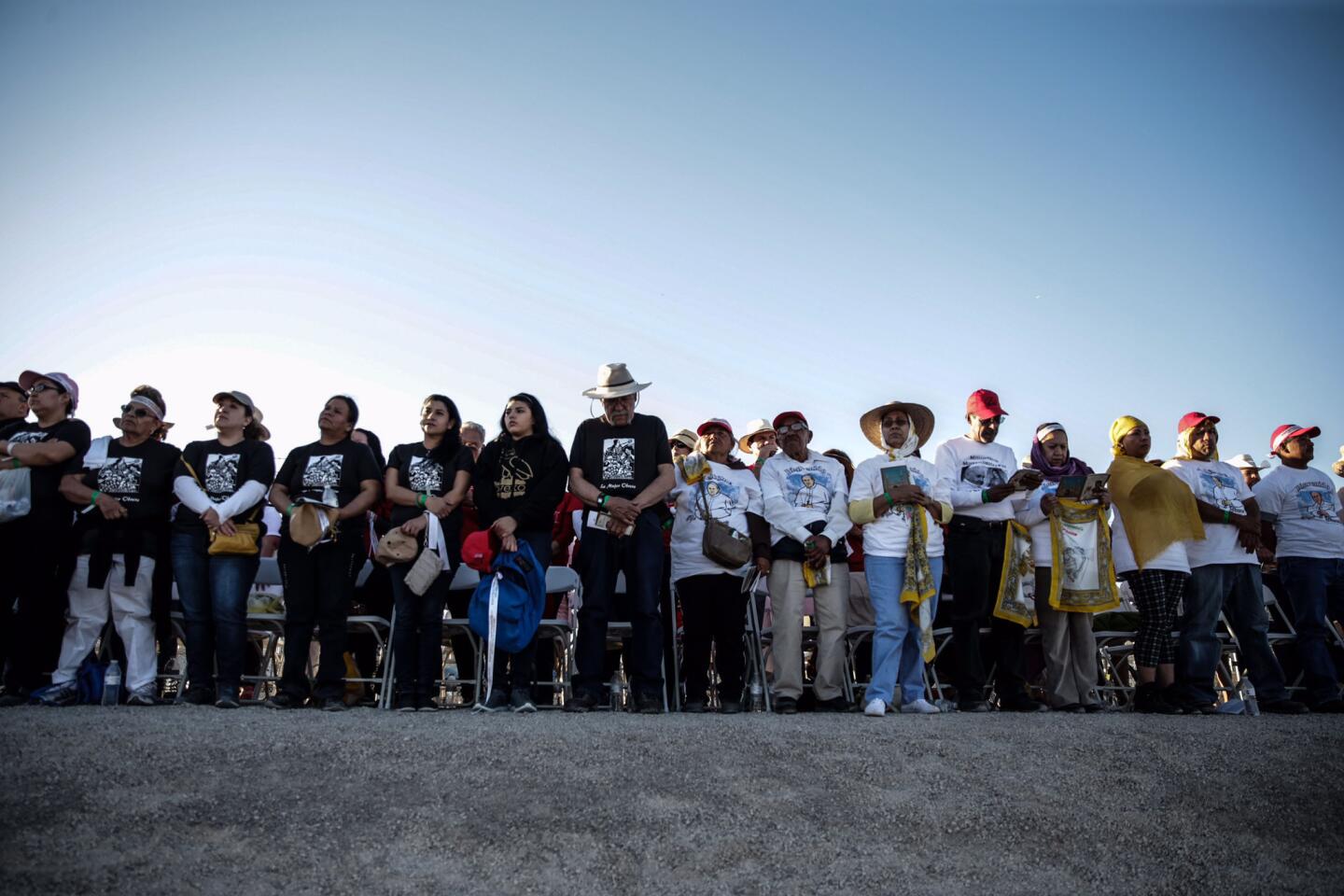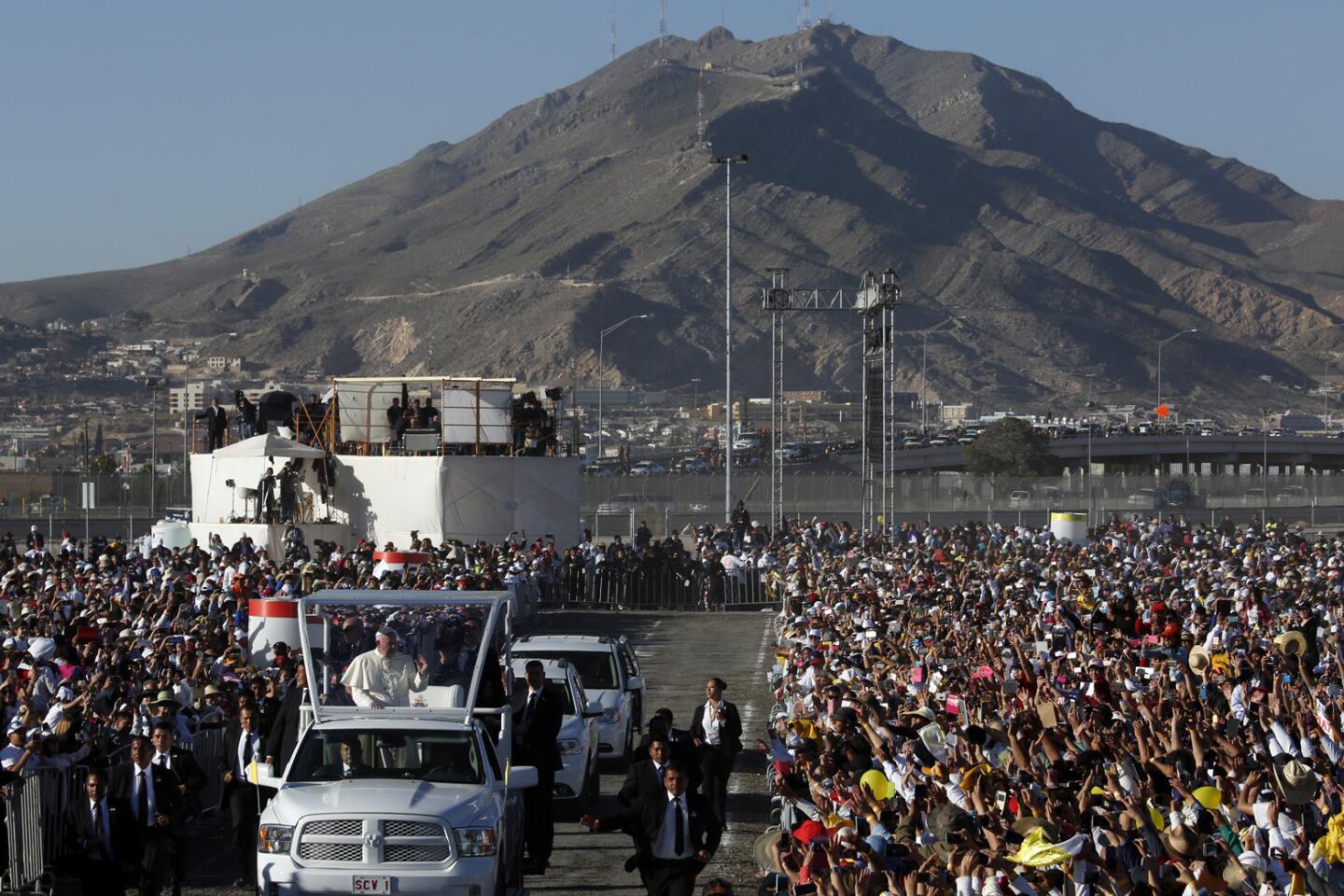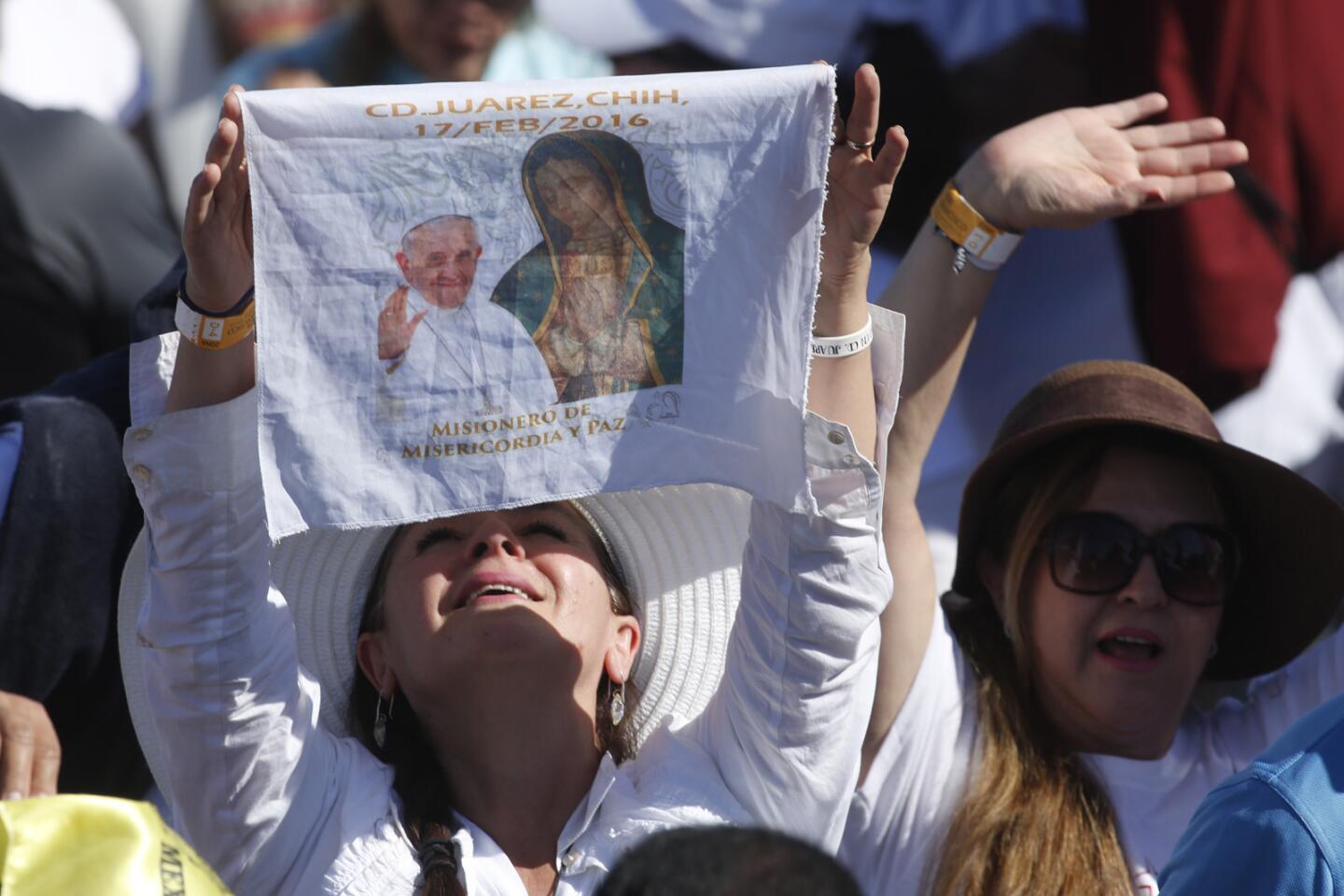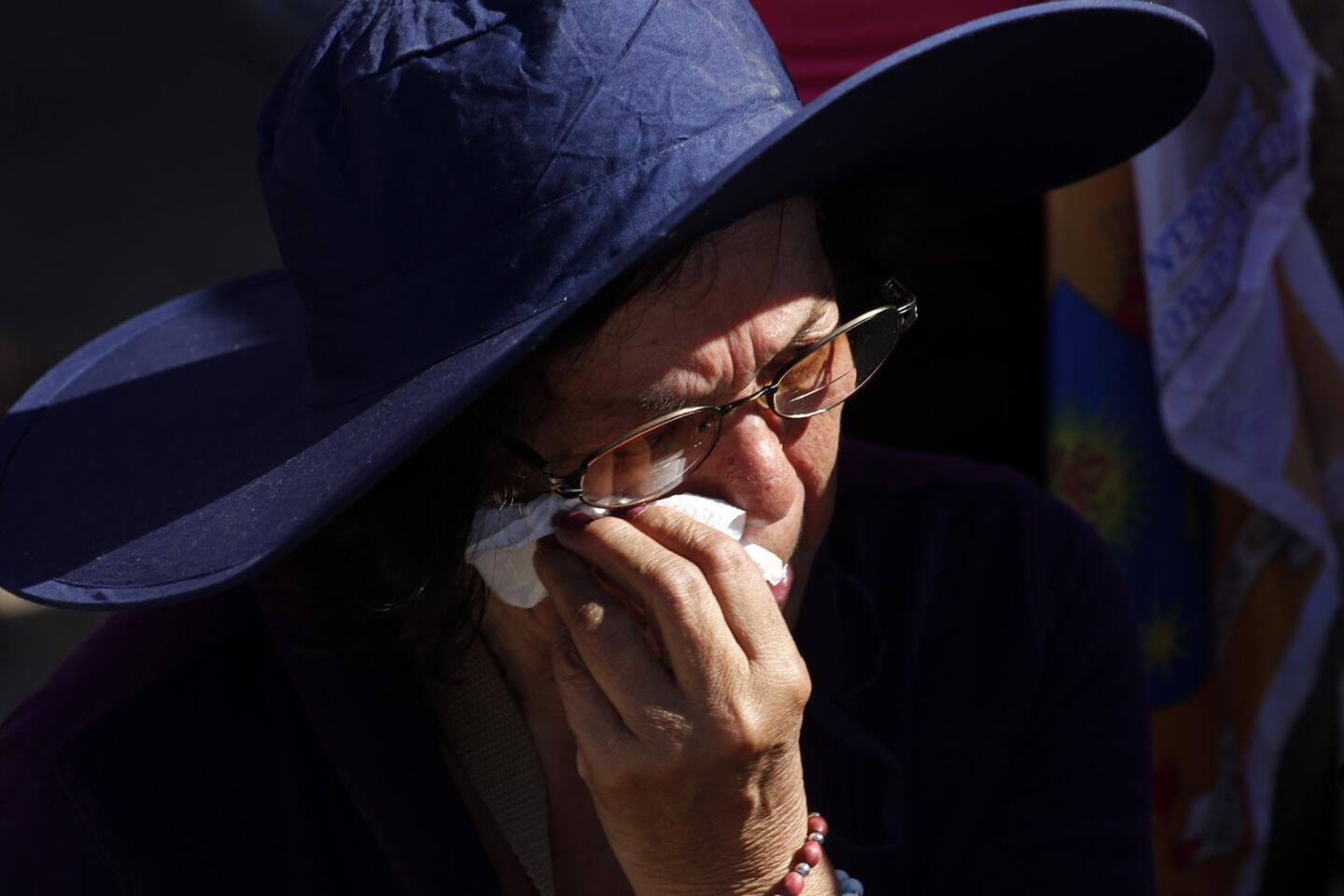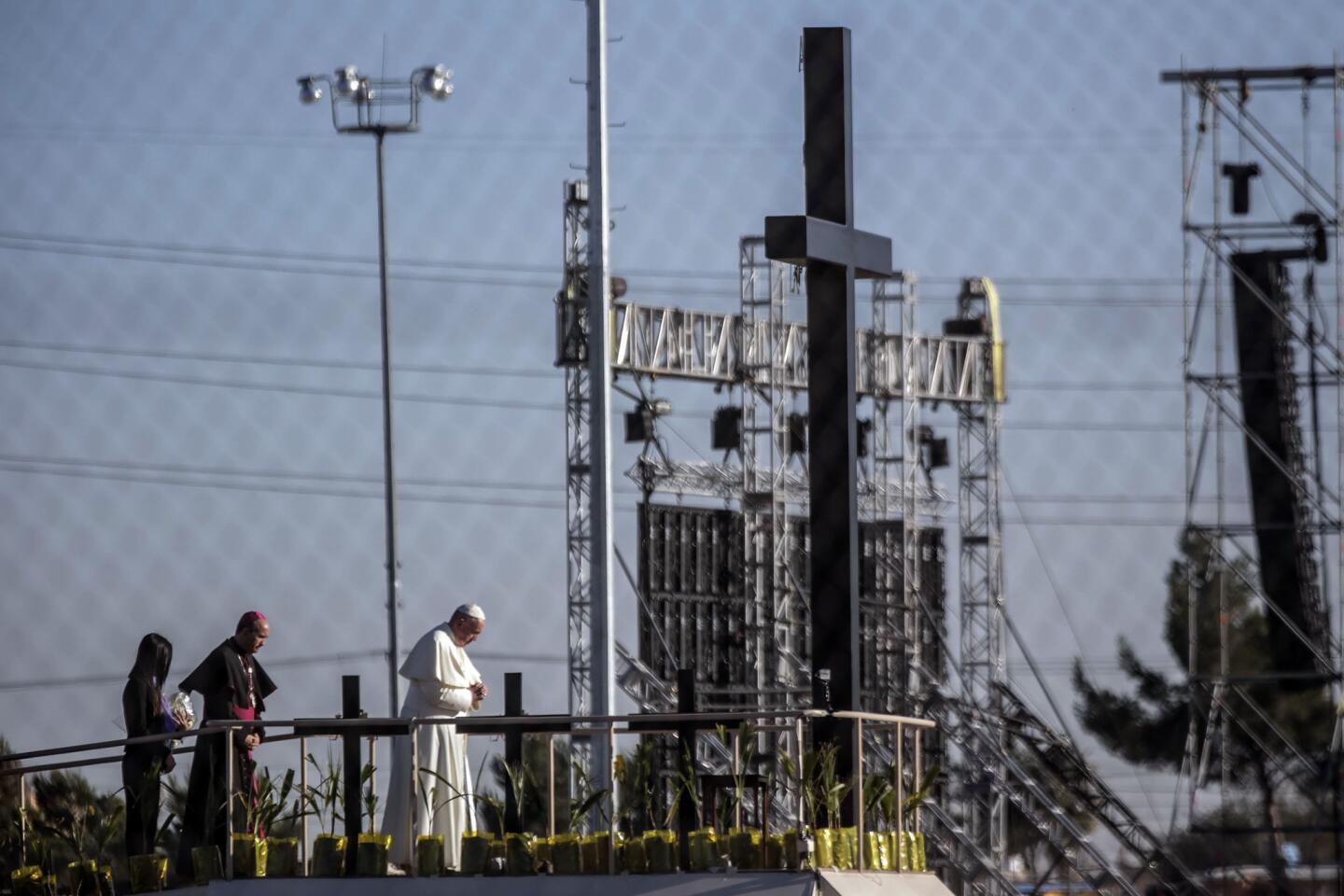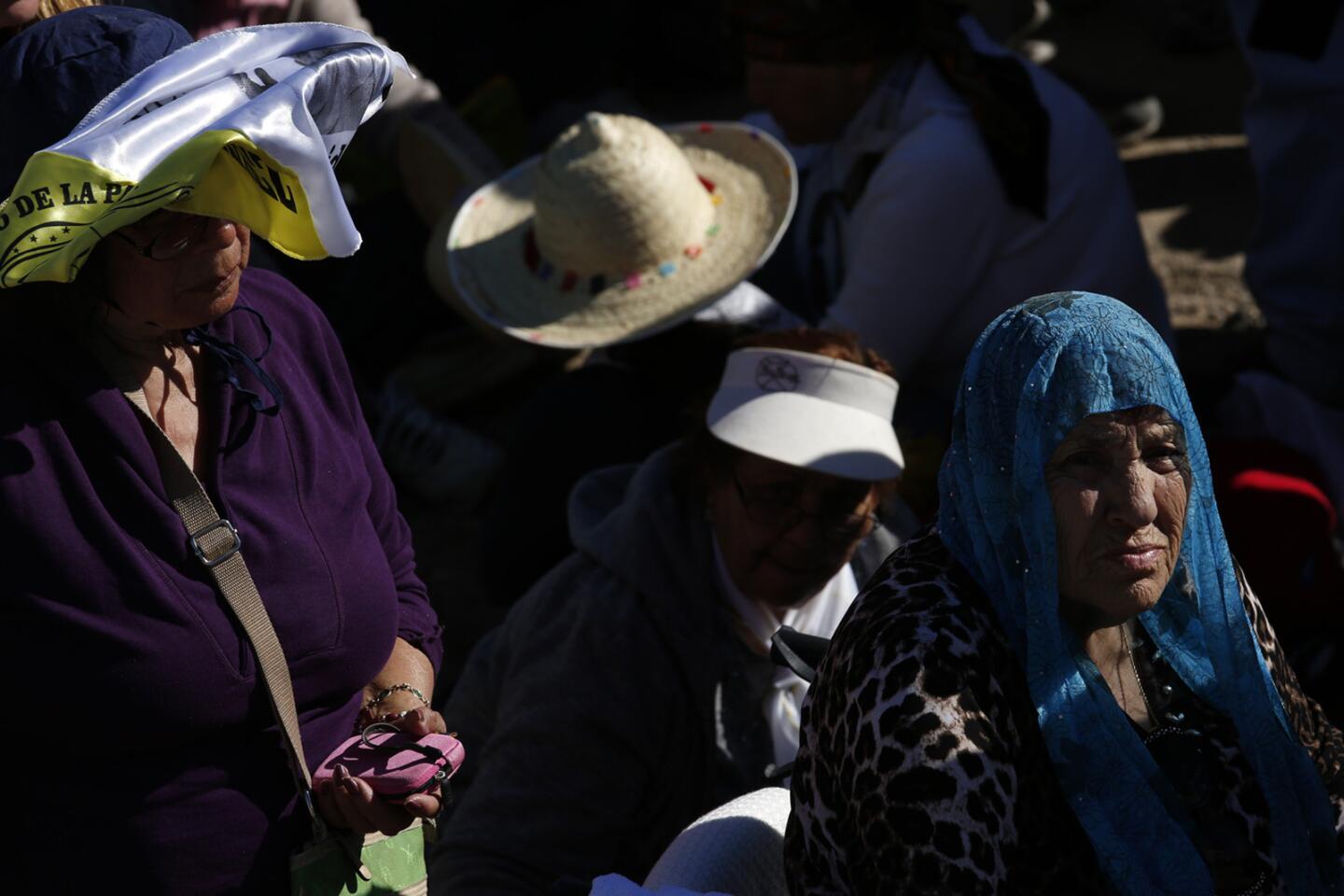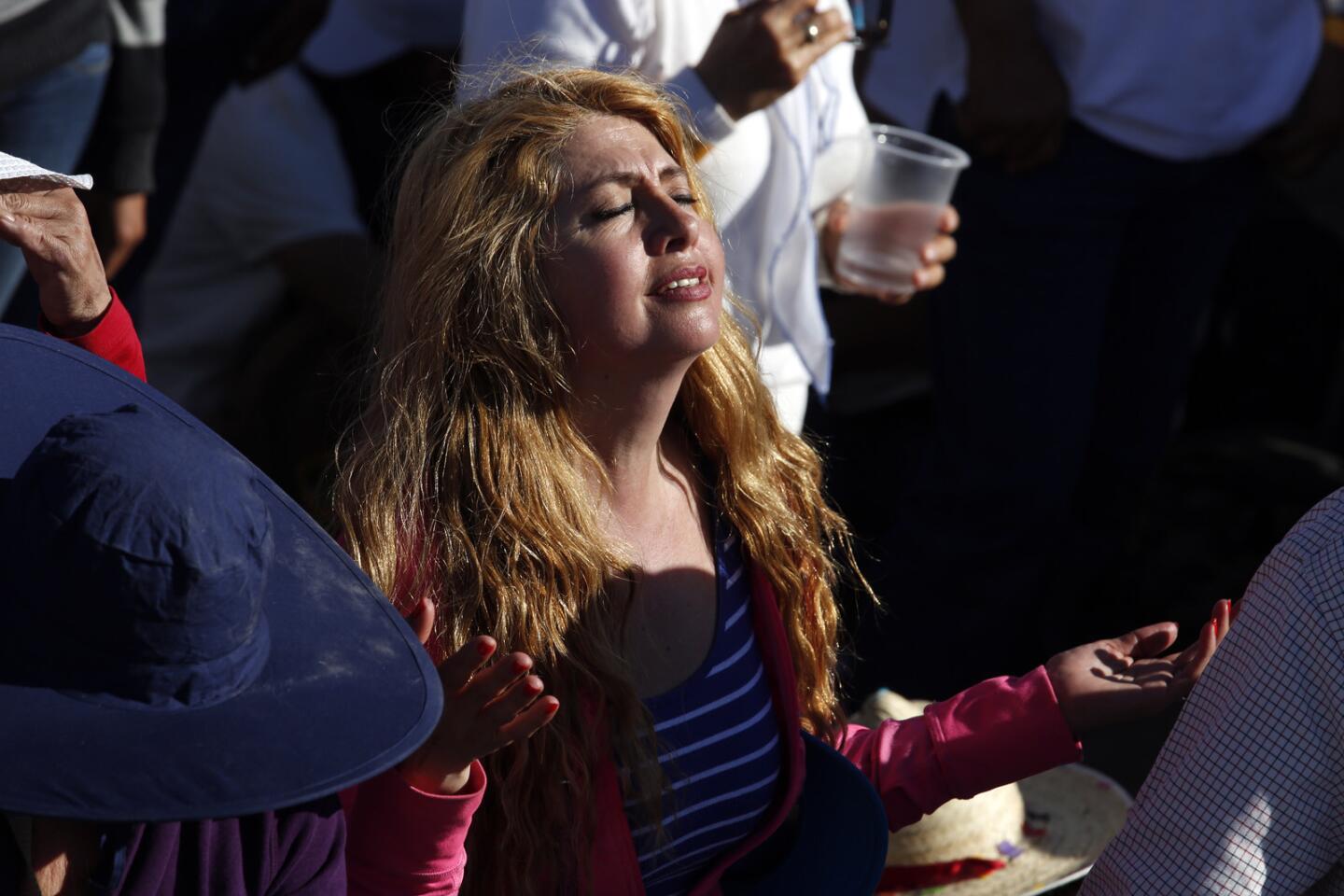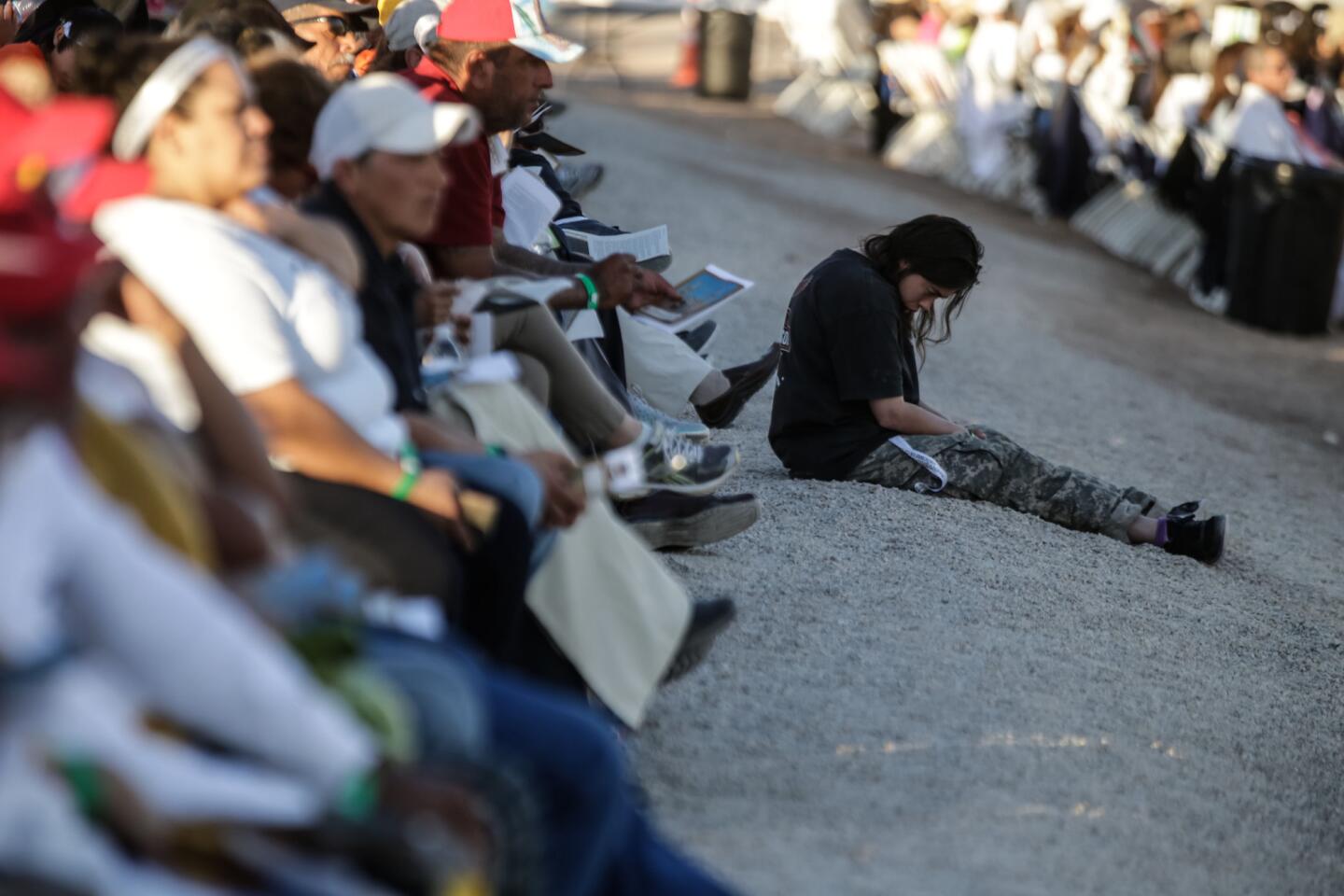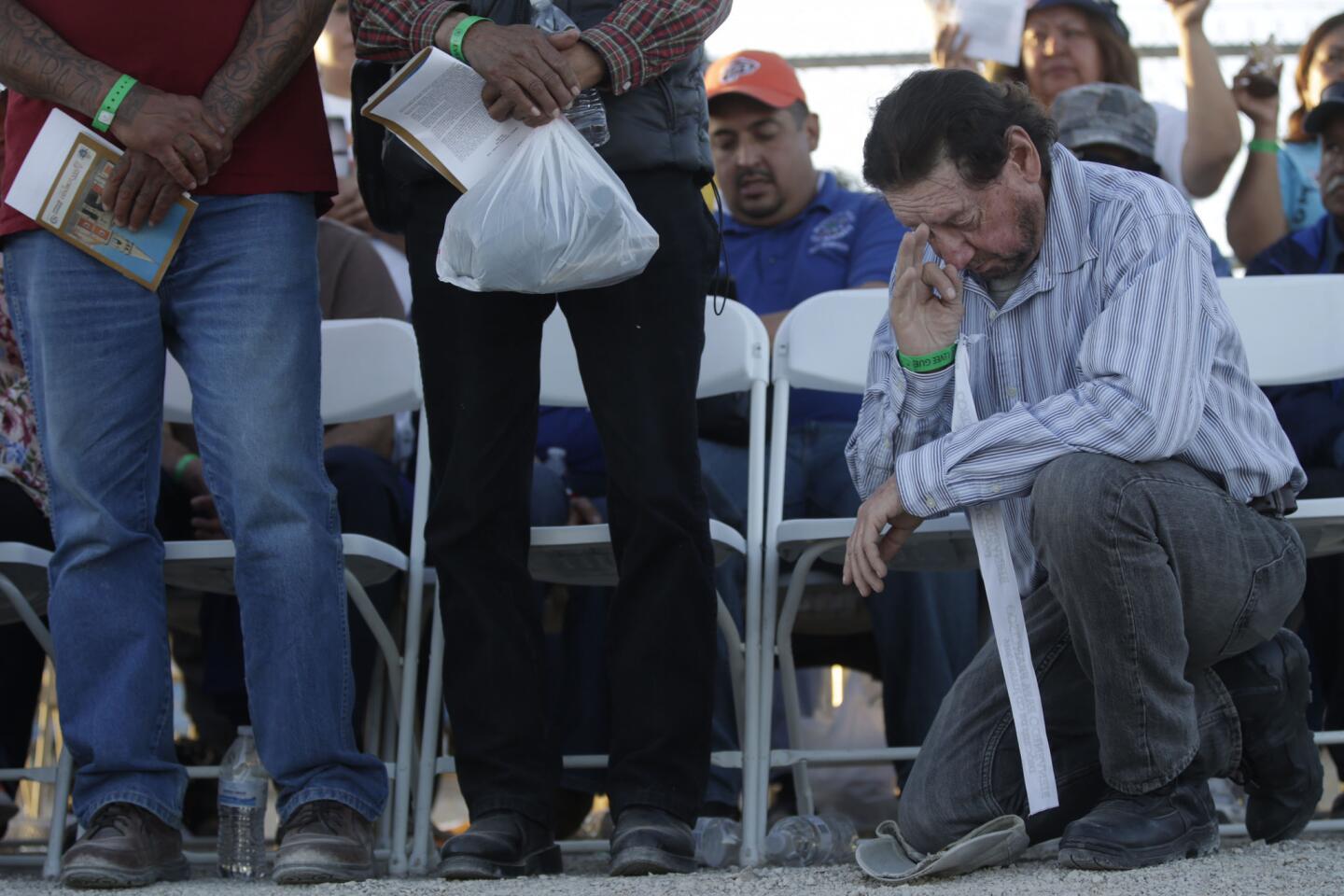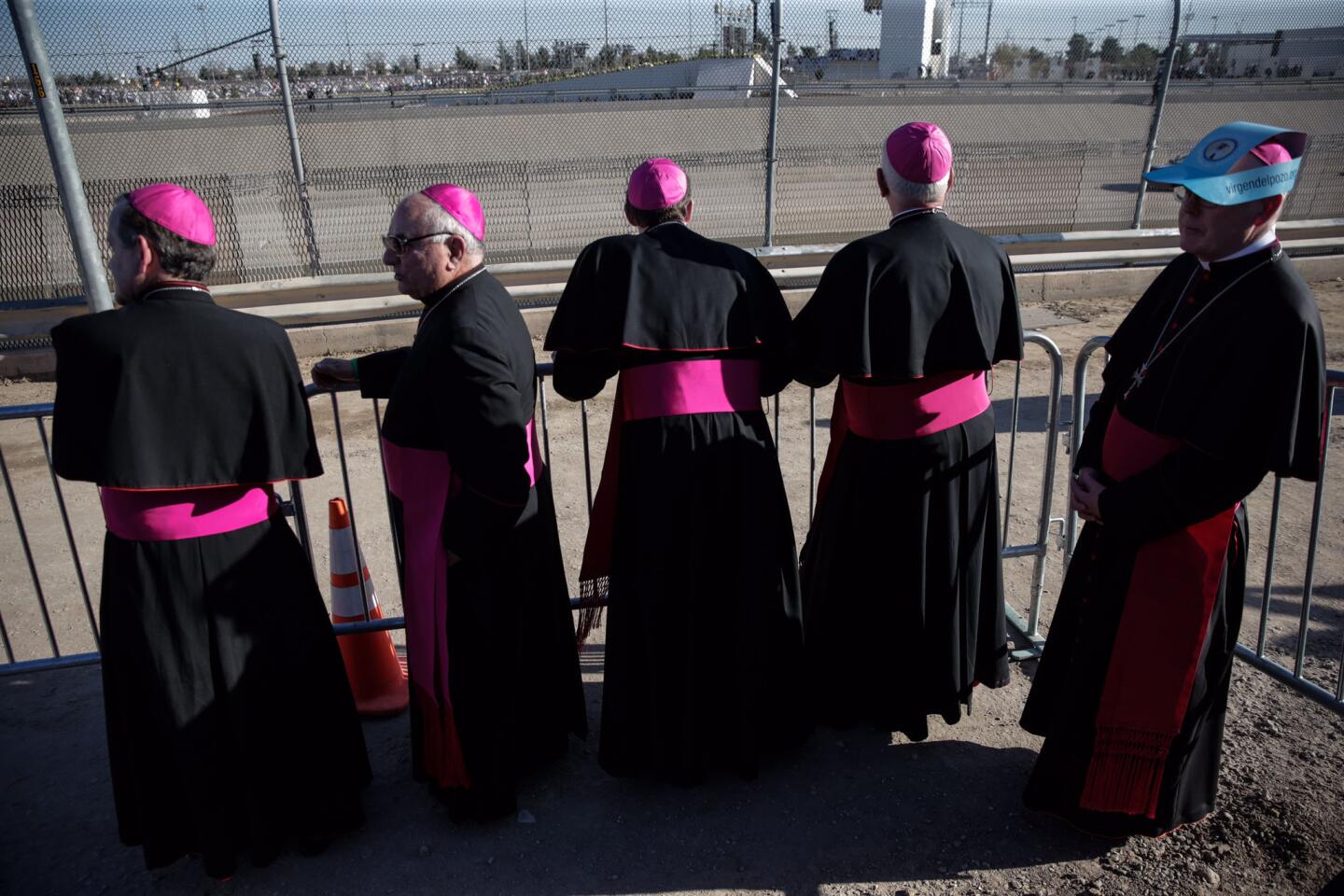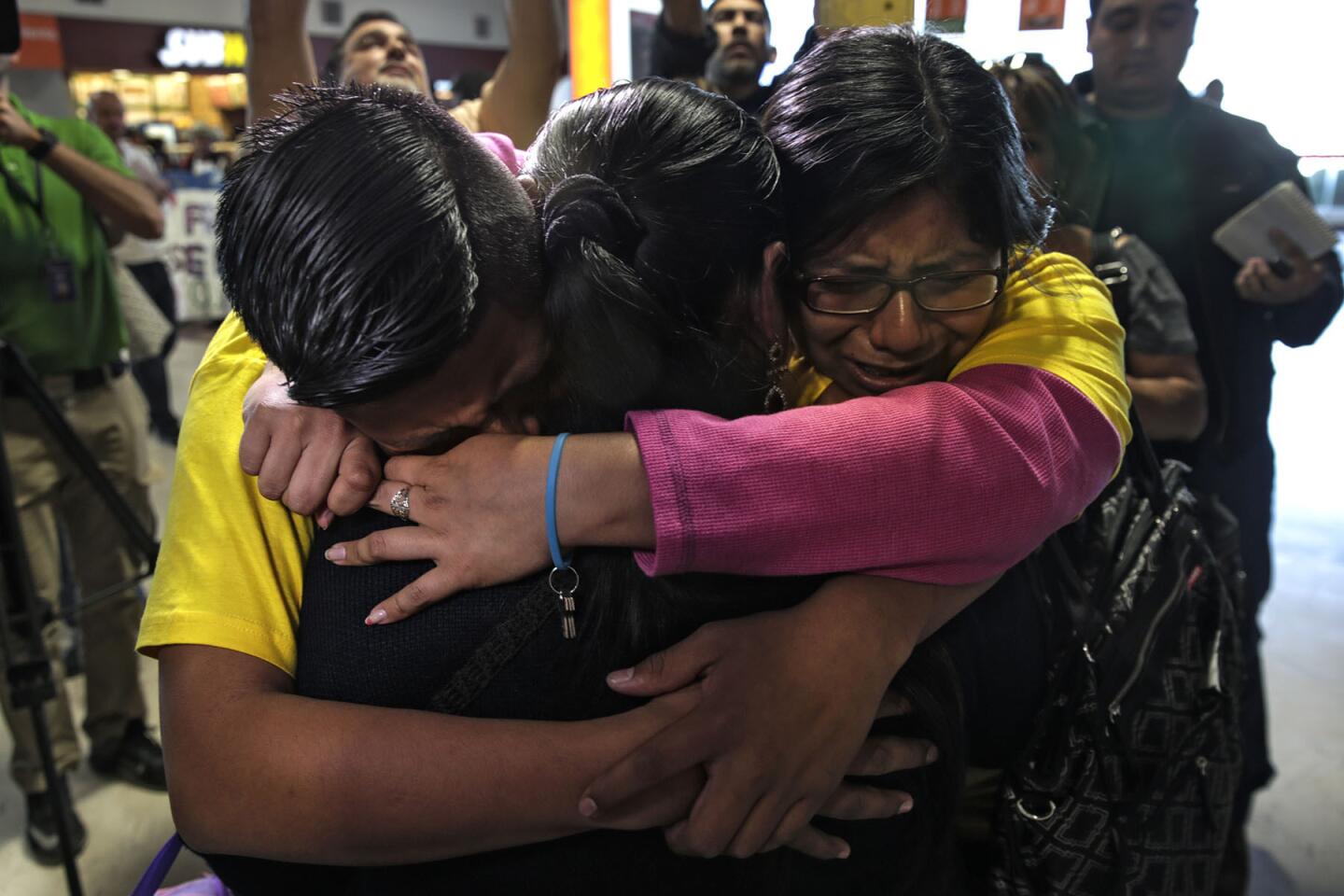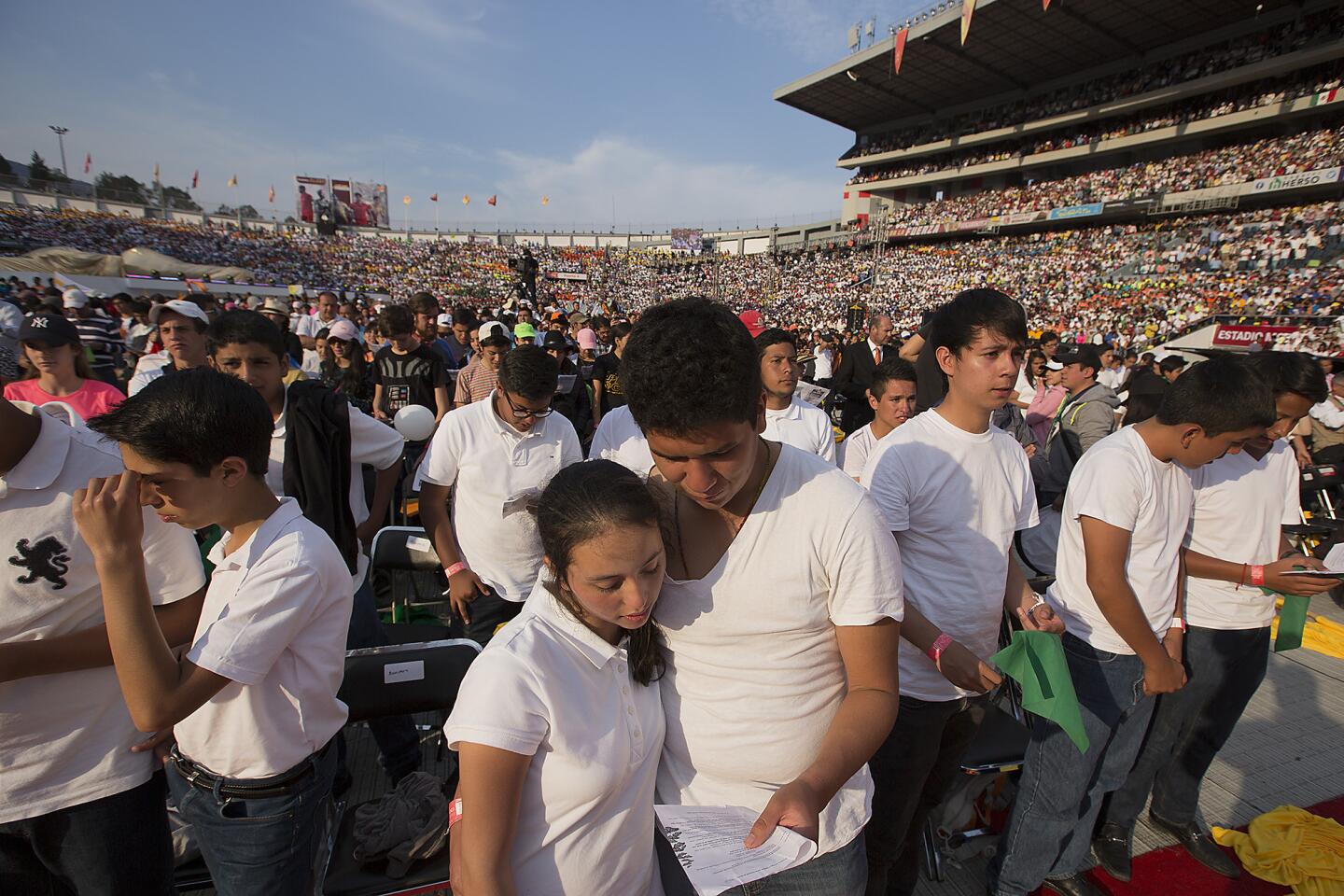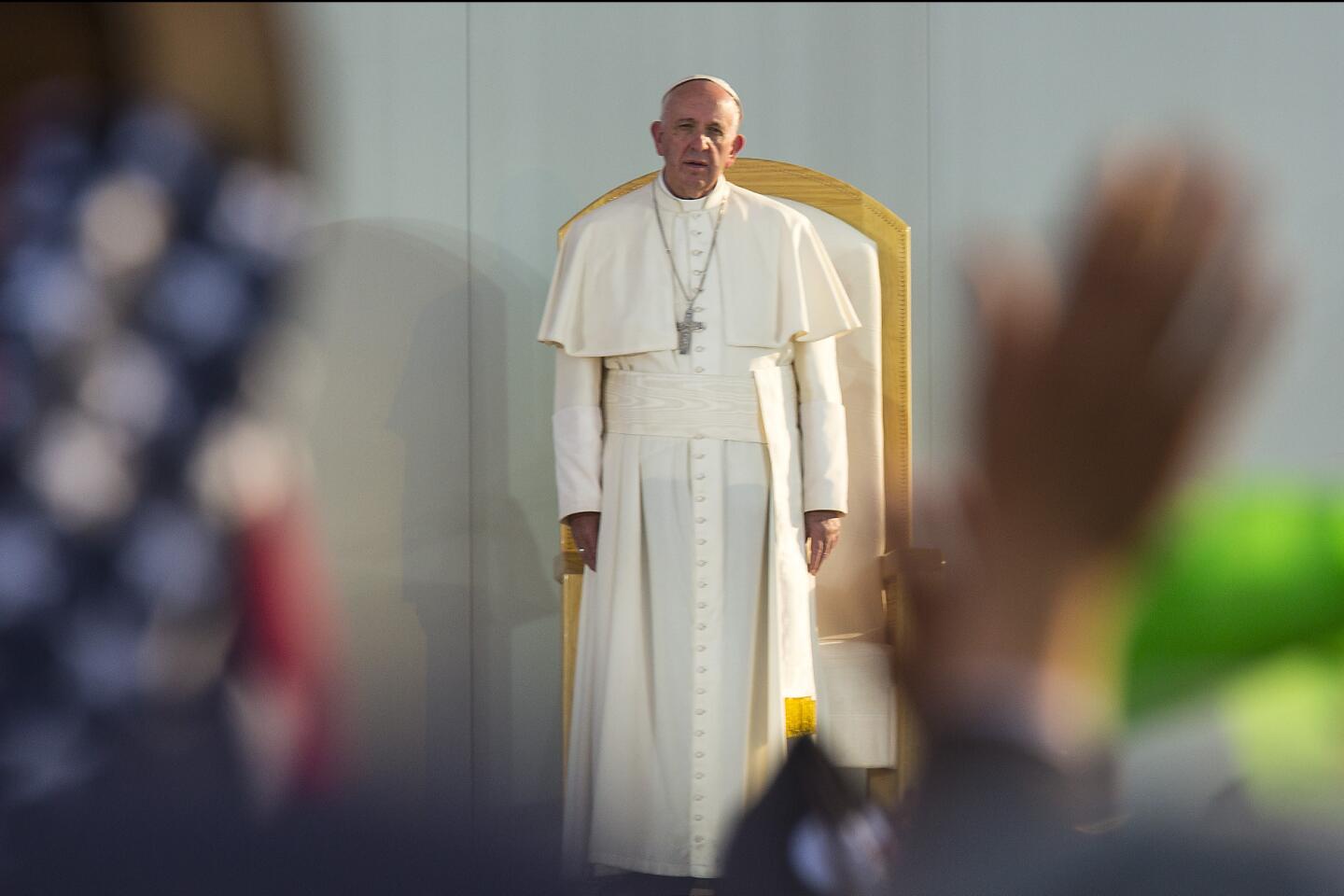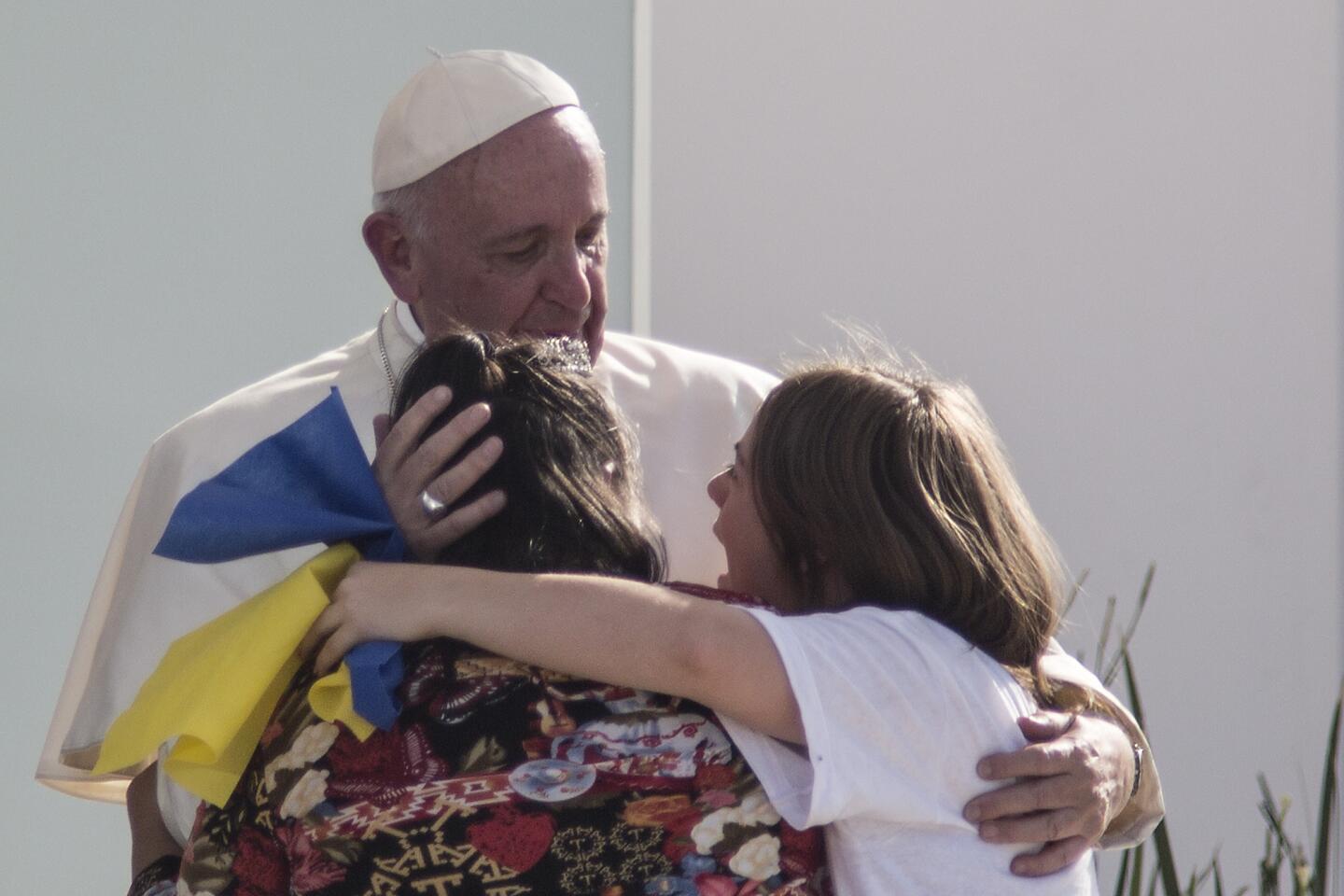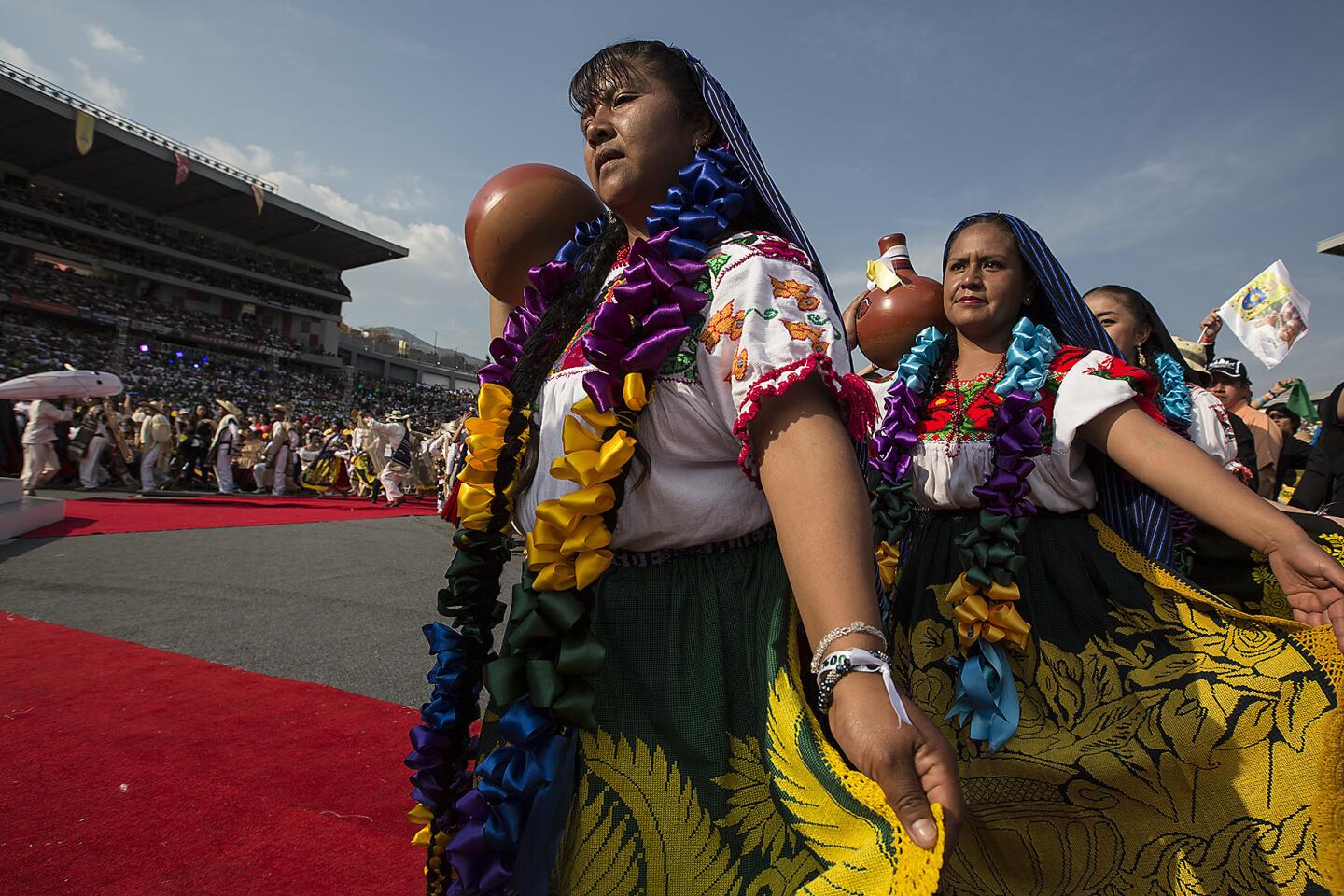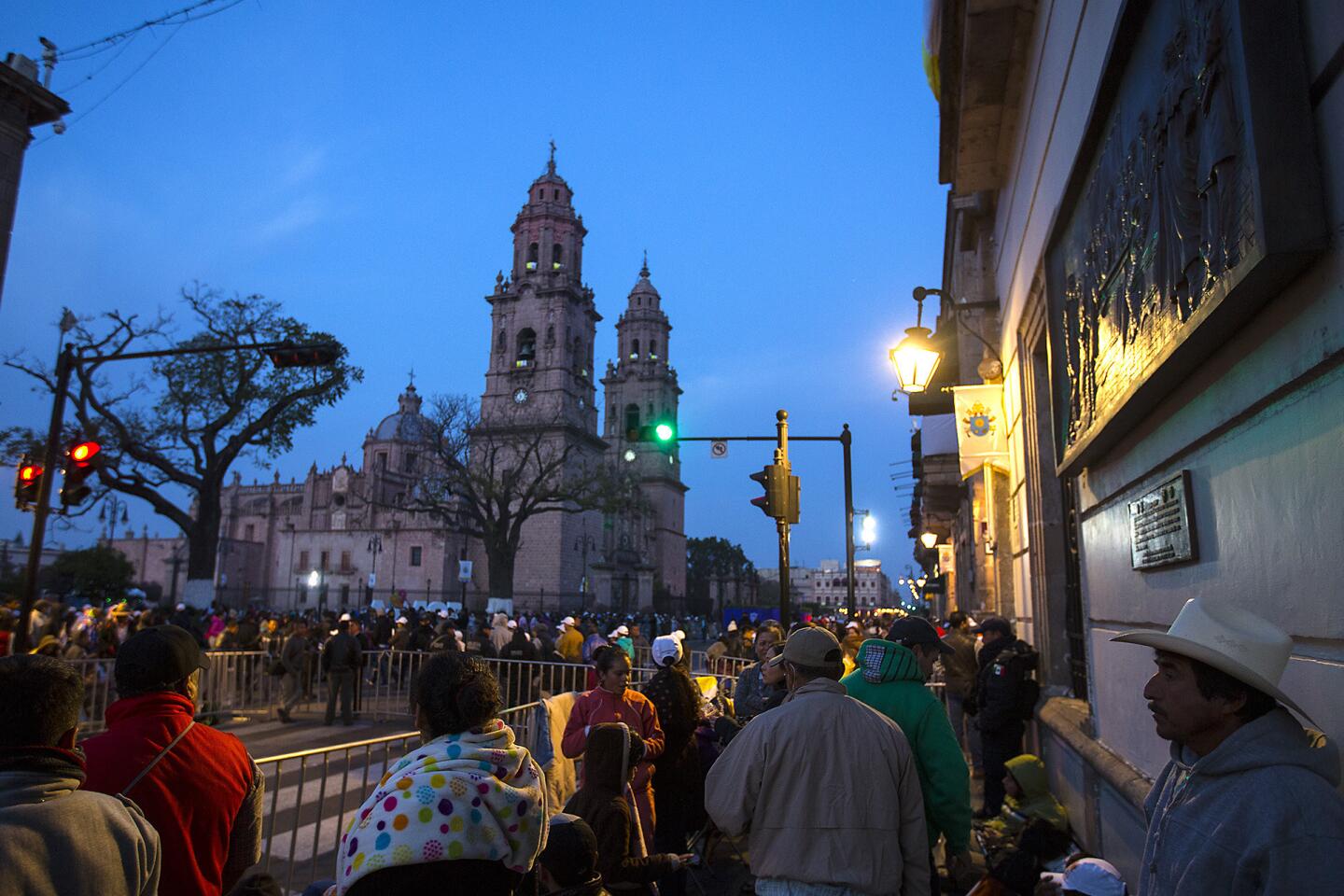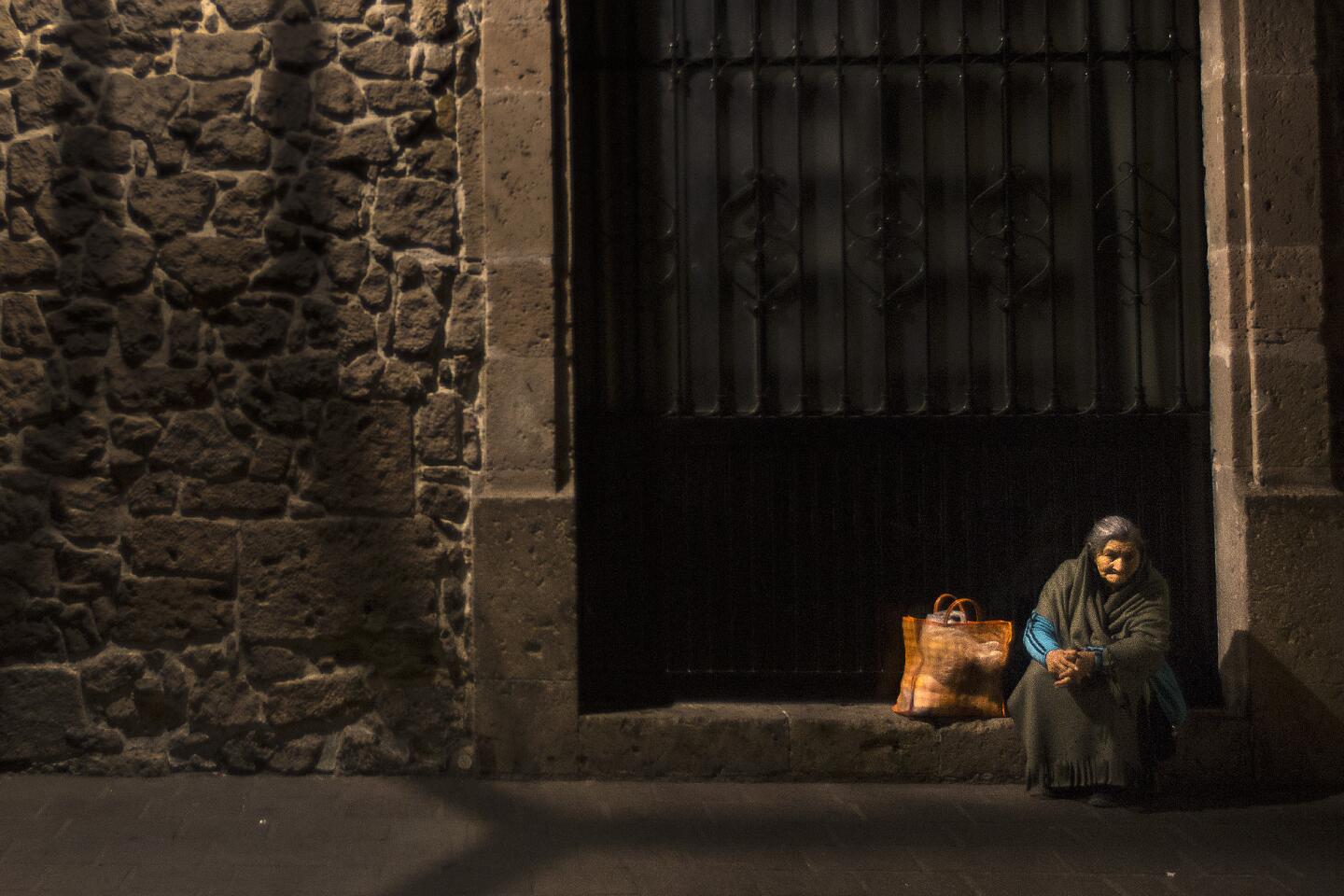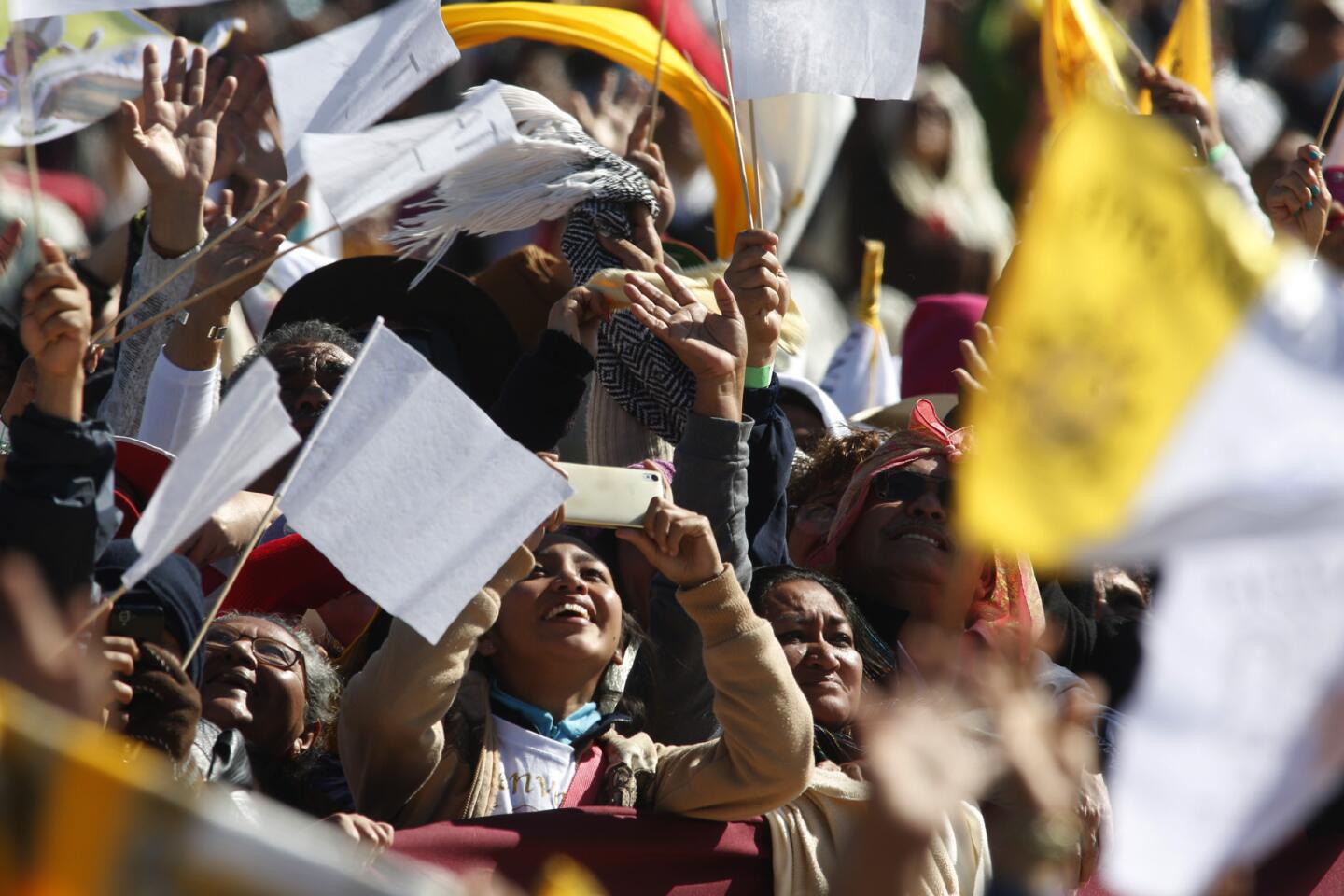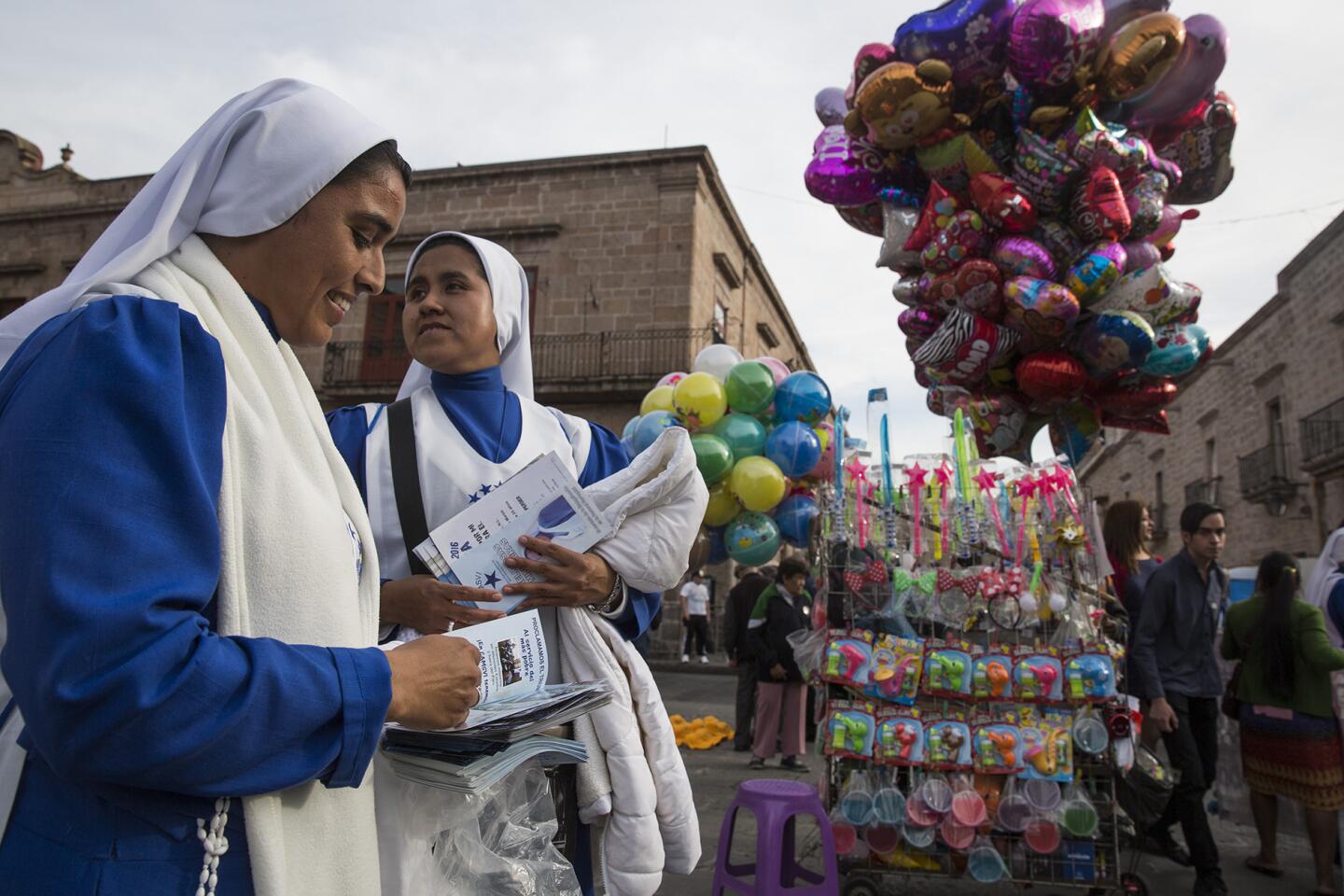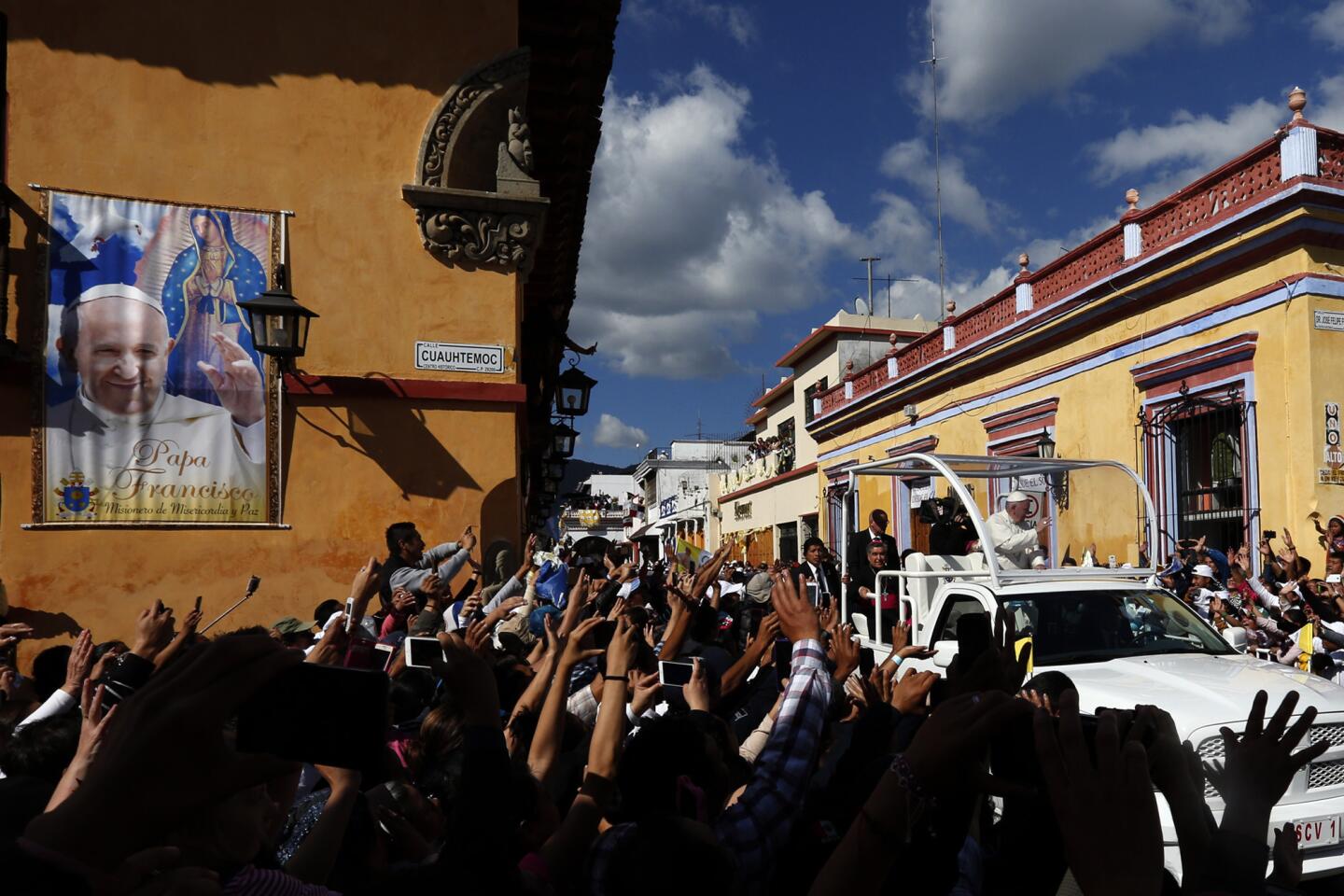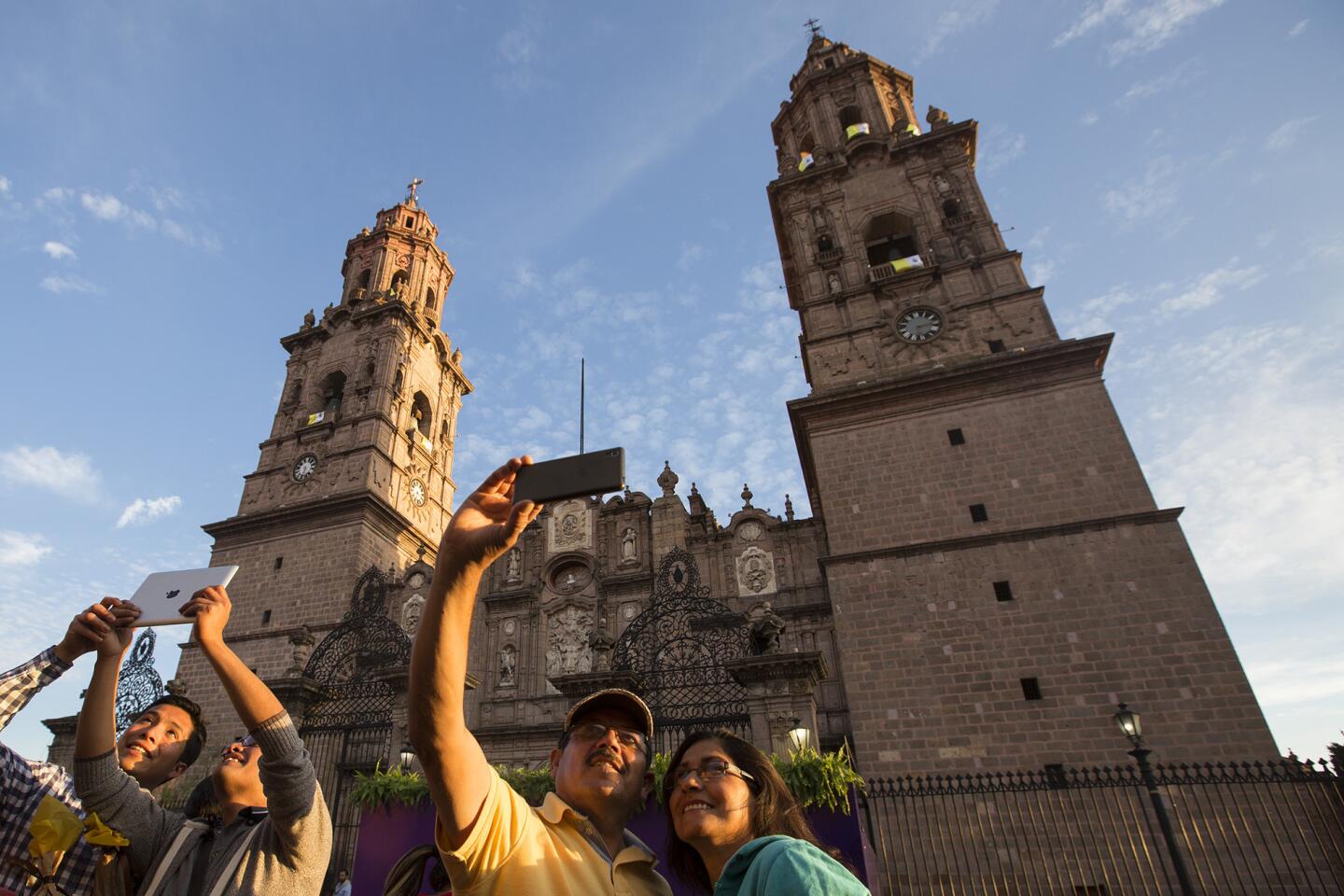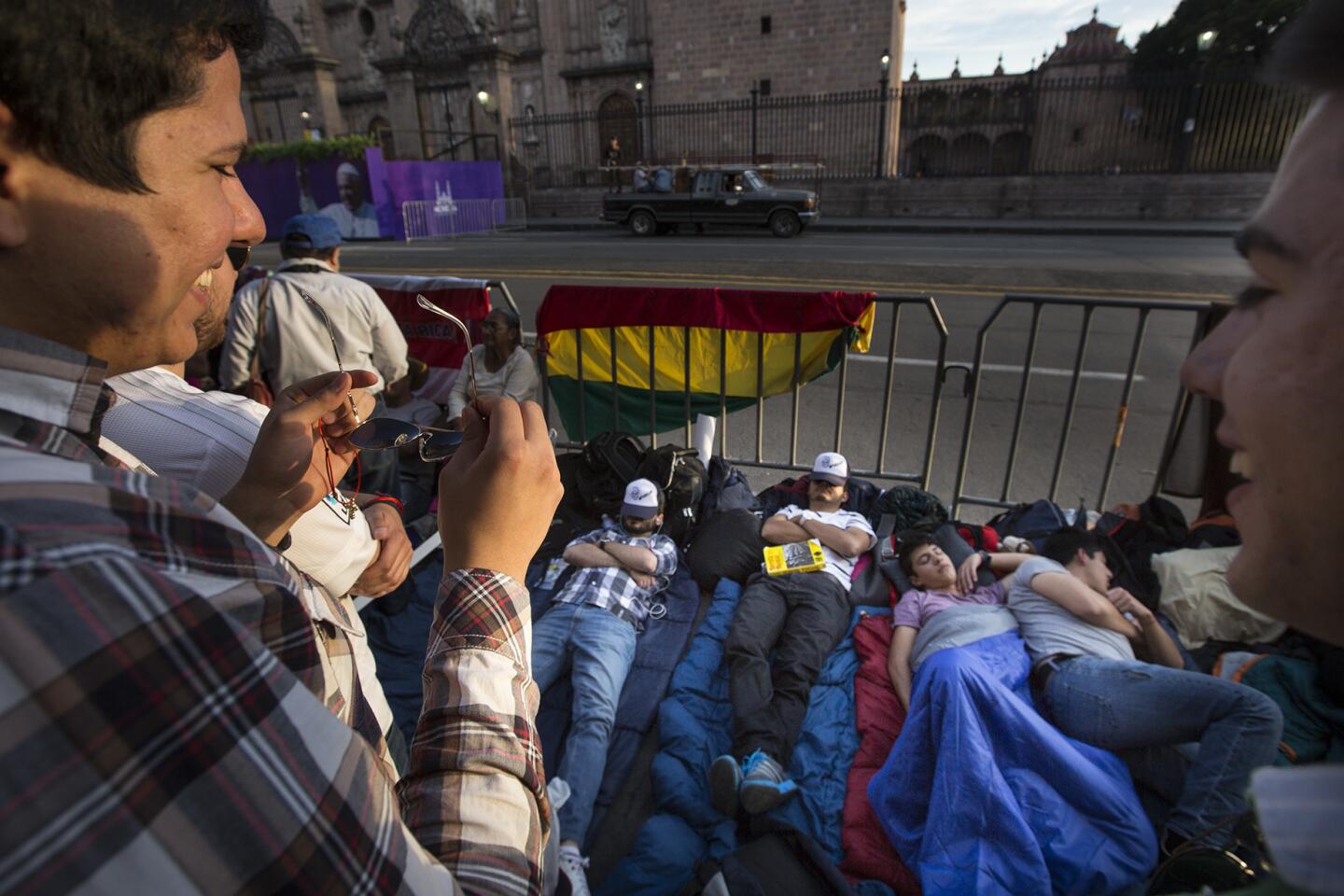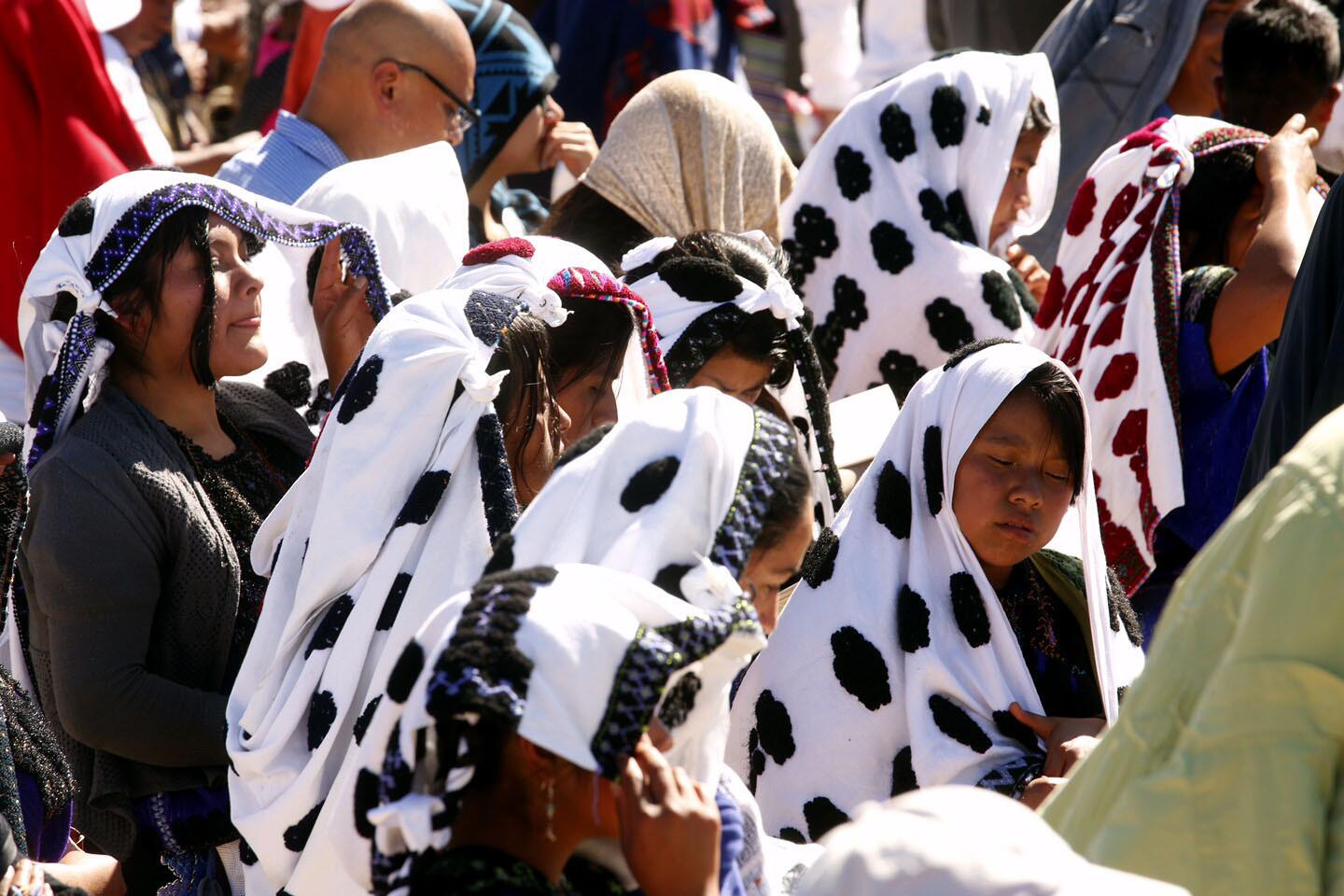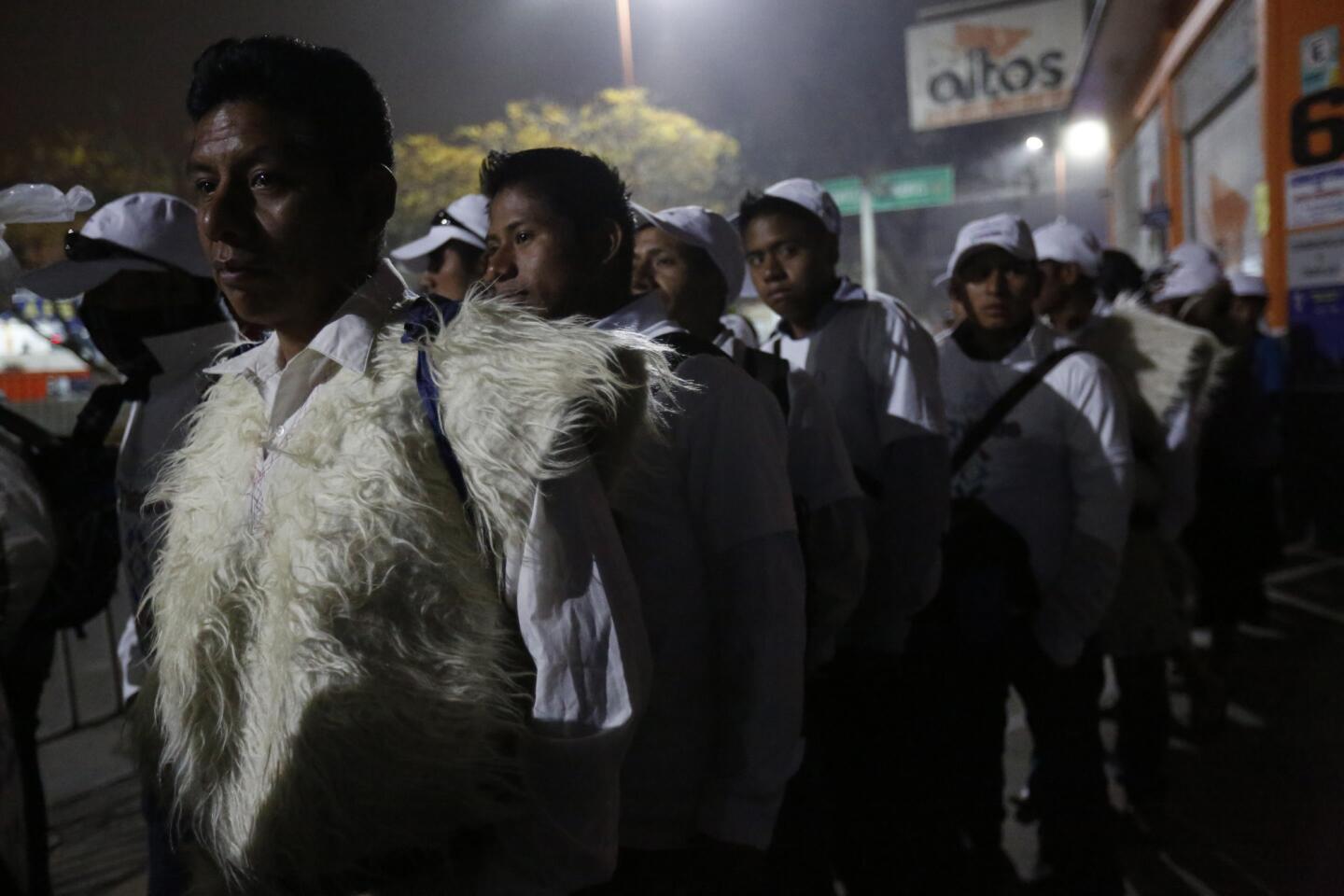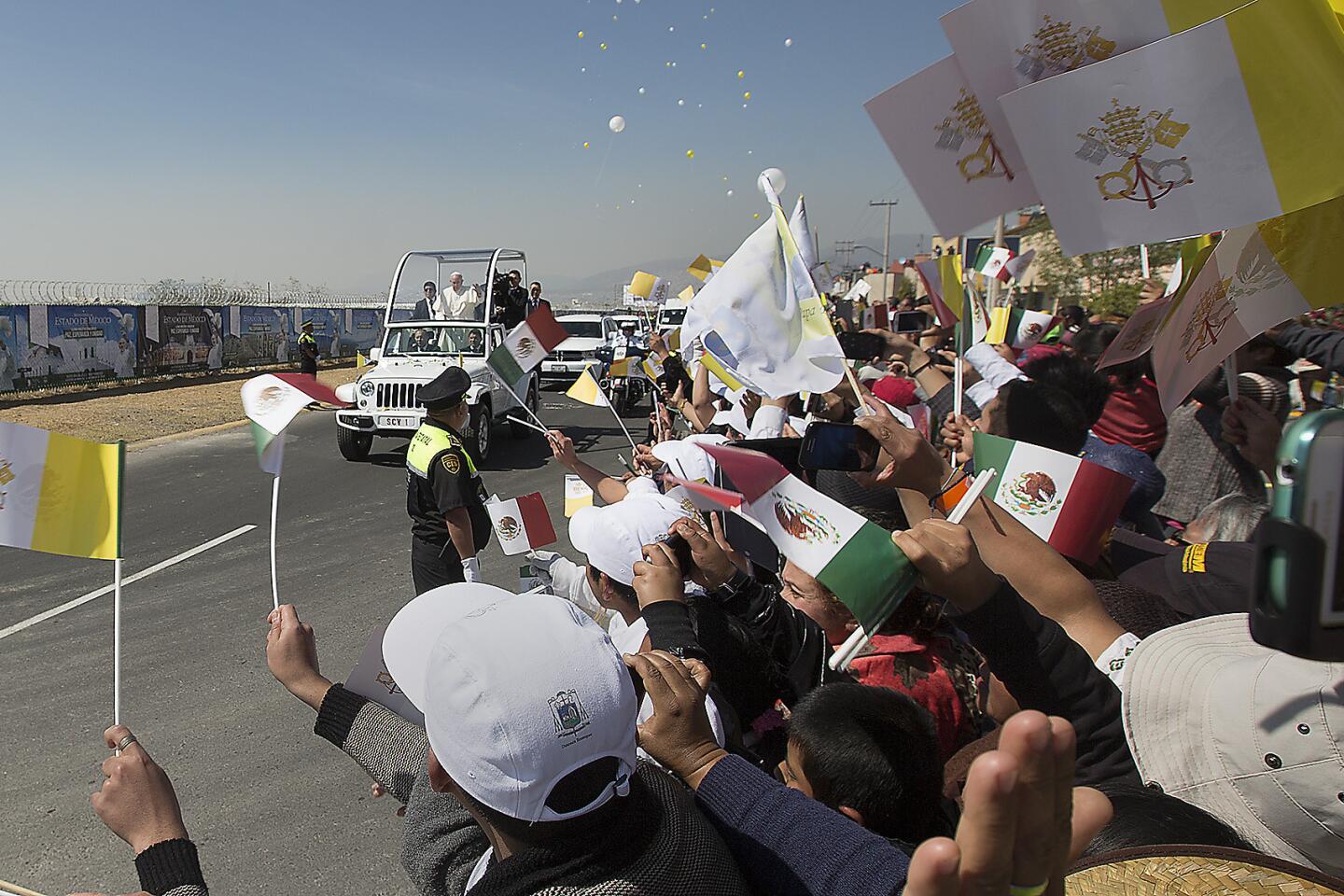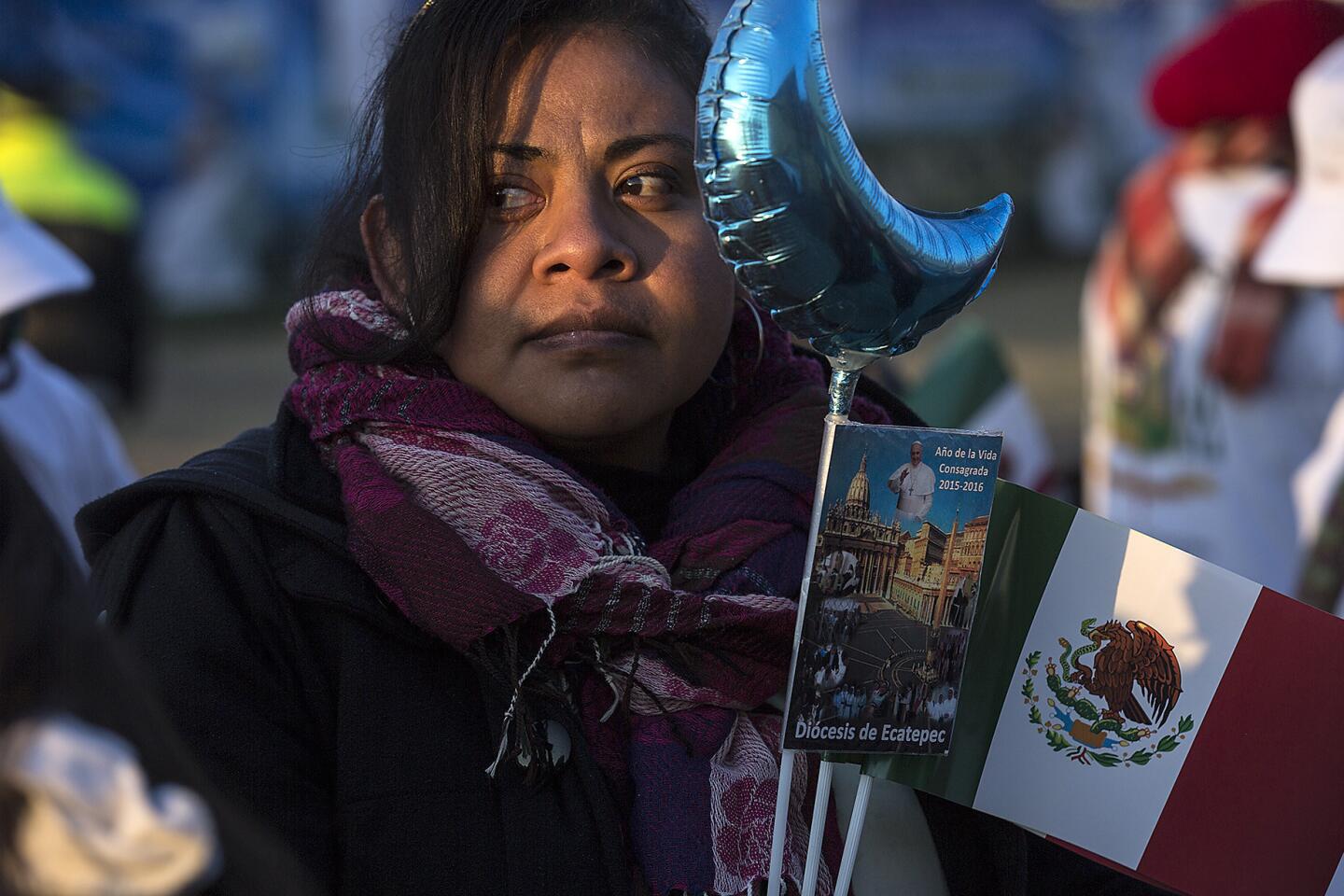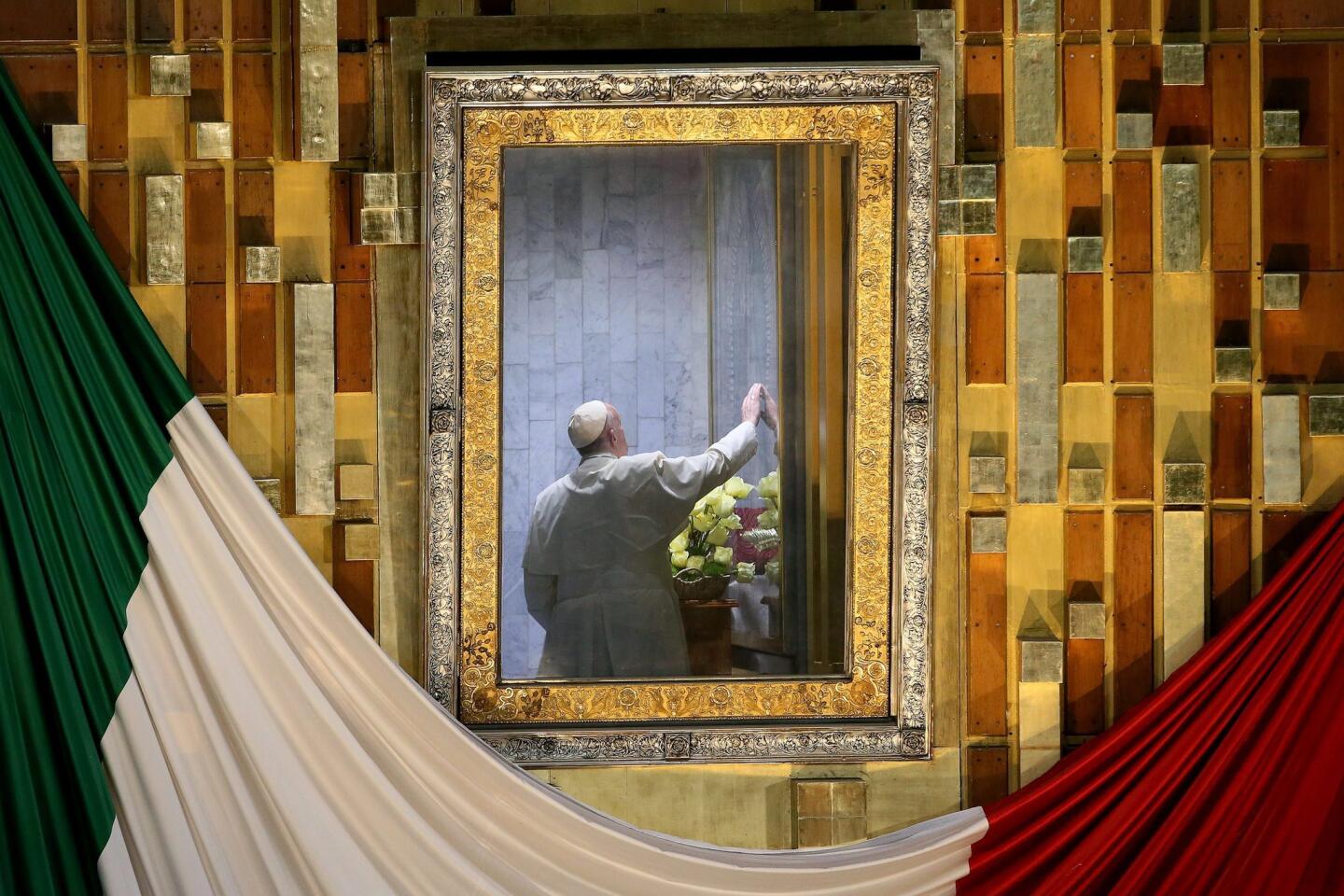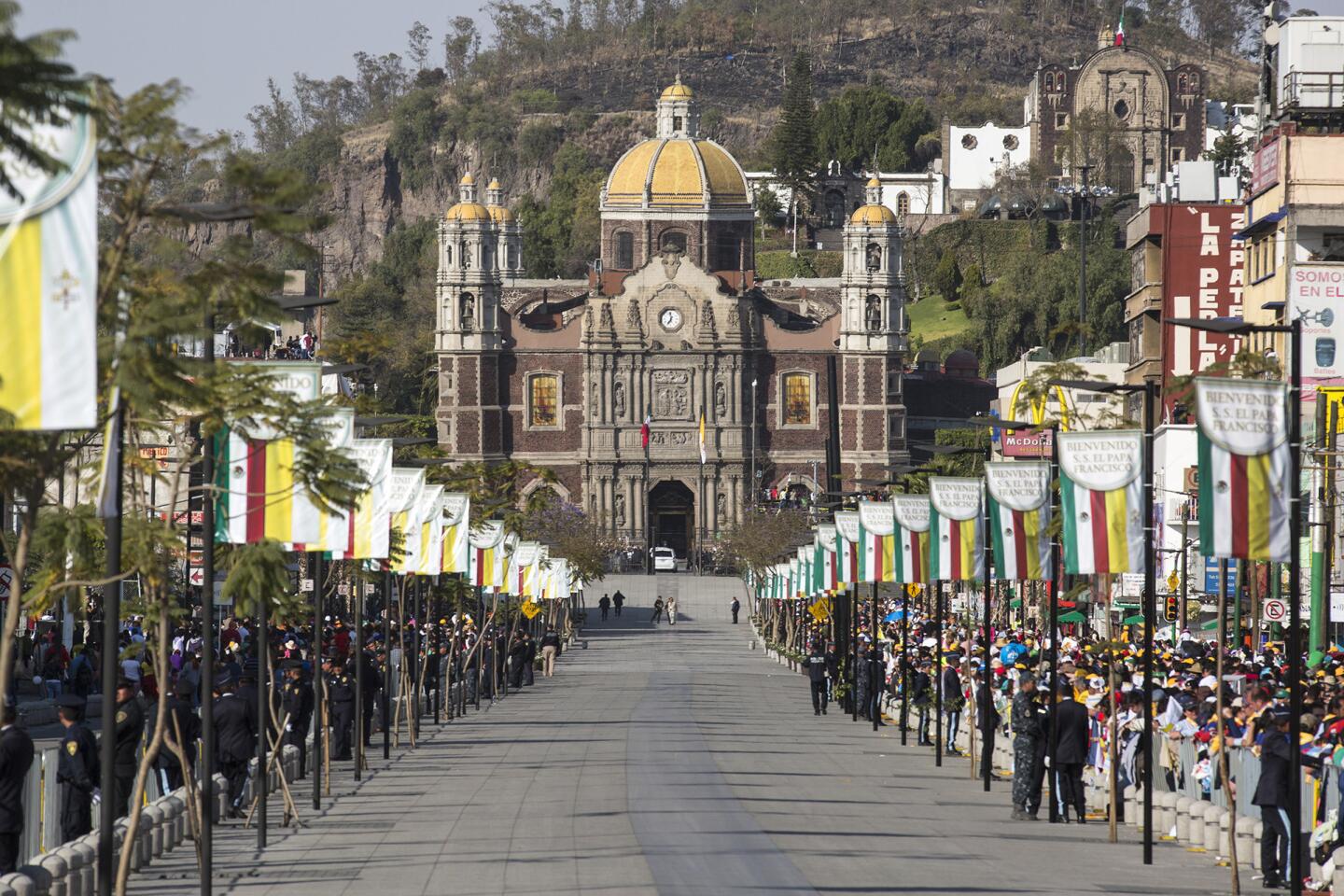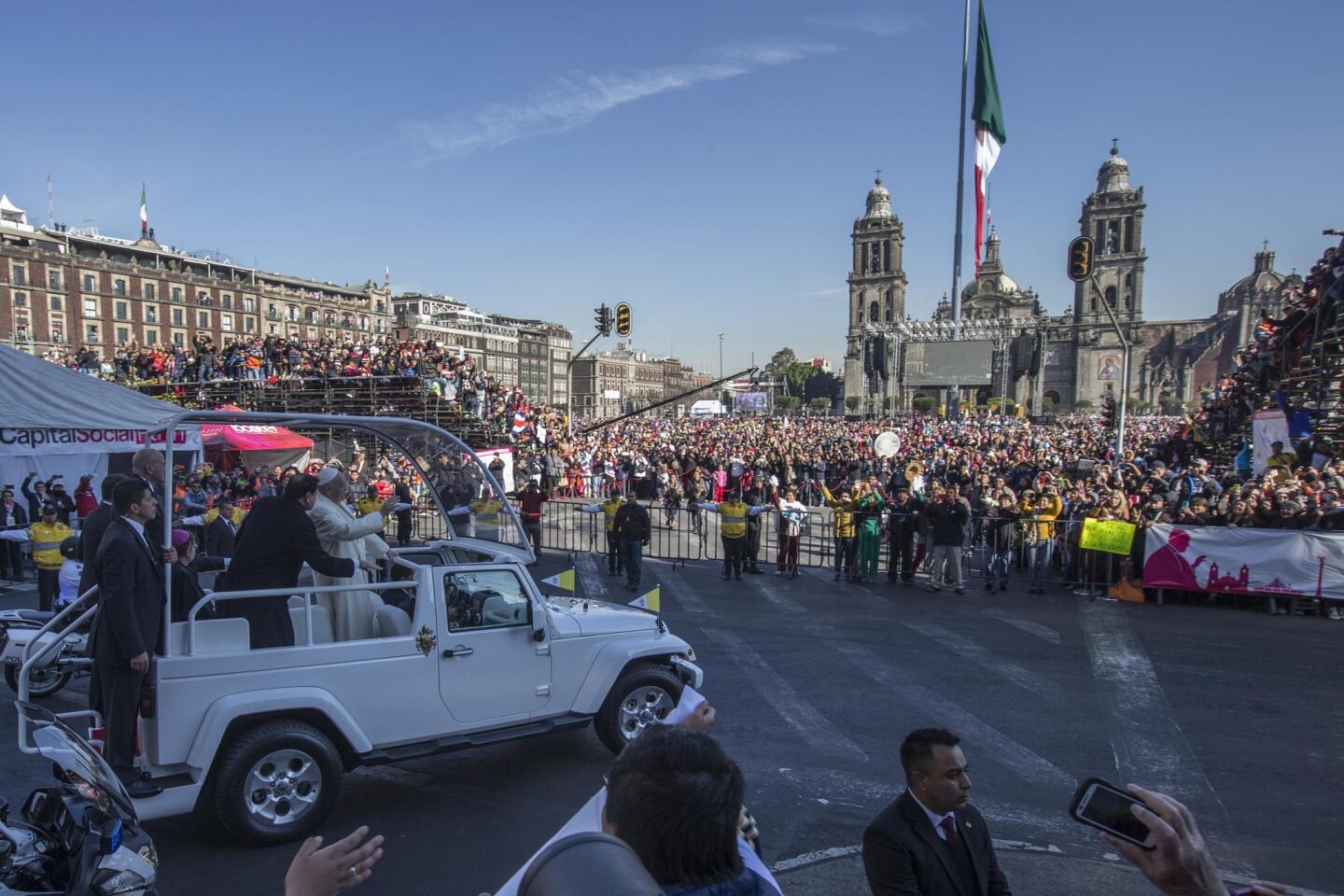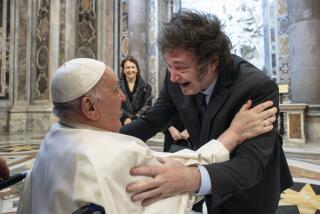In a Mass in Chiapas, Pope Francis denounces the exclusion of Mexico’s native peoples
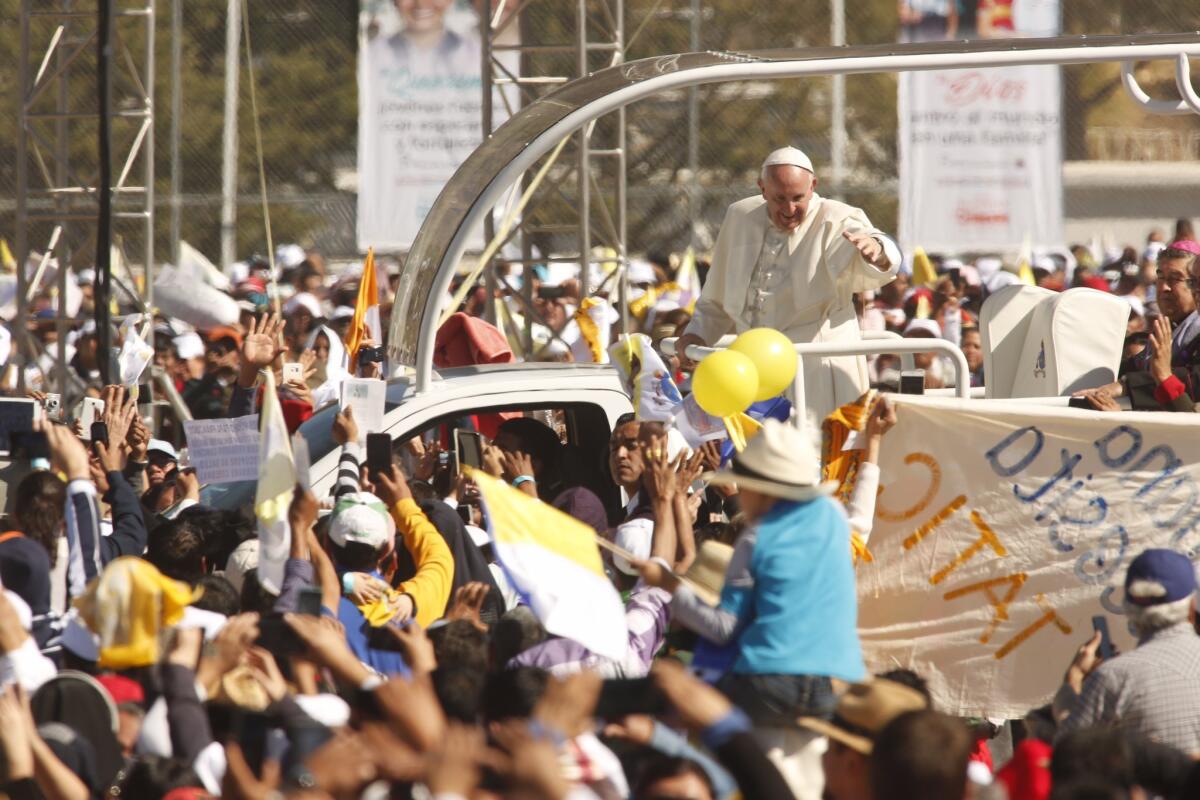
In a Mass sprinkled with indigenous languages and customs, Pope Francis on Monday gave recognition to the “misunderstood” and “excluded” native peoples long repressed by Mexican power.
Traveling to the heart of indigenous Mexico, the pope presided over a sun-drenched religious ceremony in San Cristobal de las Casas, in Chiapas state — Mexico’s poorest, on its southern border with Guatemala.
“On many occasions, in a systematic and organized way, your people have been misunderstood and excluded from society,” the pope said.
Join the conversation on Facebook >>
While the powers of the moment dismissed indigenous values as inferior, he said, they also stole or contaminated the lands belonging to the indigenous.
“How sad this is!” the pope said. “Exposed to a culture that seeks to suppress all cultural heritage and features in pursuit of a homogenized world, the youth of today need to cling to the wisdom of their elders!”
Prayers and scriptural readings were given in Tzotzil and Tzeltal and other indigenous languages. The pope spoke a few words in Tzotzil: “The law of the lord is perfect, and his word revives the soul.”
Chiapas state, whose land was once a stronghold of the Mayan civilization, has one of the country’s largest indigenous populations and is home to many ancient Mayan ruins, including Palenque and Bonampak.
Inside the sports stadium in San Cristobal, thousands of indigenous people in local dress watched as the pope presided over the solemn mass.
At the end of the Mass, local priests gave the pope a pair of Bibles translated into Tzotzil and Tzeltal. The Bibles took 25 years to translate, according to church authorities. The Mass also included readings in Chol, another Mayan language.
The Mass was a massive spectacle, featuring indigenous and other musical groups from throughout Mexico, as well as regional dances. The bishop of Chiapas, Felipe Arizmendi, joined in the dancing.
The pope wore a cassock with embroidery from the town of Zinacantan, where artisans are known for their sewing skills.
Indigenous people from Zinacantan, recognizable by their colorful blouses and ponchos with extensive floral designs, were prominent among those attending the mass. Indigenous work was also incorporated into the pope’s mitre, or head dress, and his staff, church authorities said.
During the mass, hundreds of musicians gathered in a patch of artificial grass to the left of the main stage, stepping up to play as their turns arrived. Many wore indigenous dress and were from local bandas, or bands.
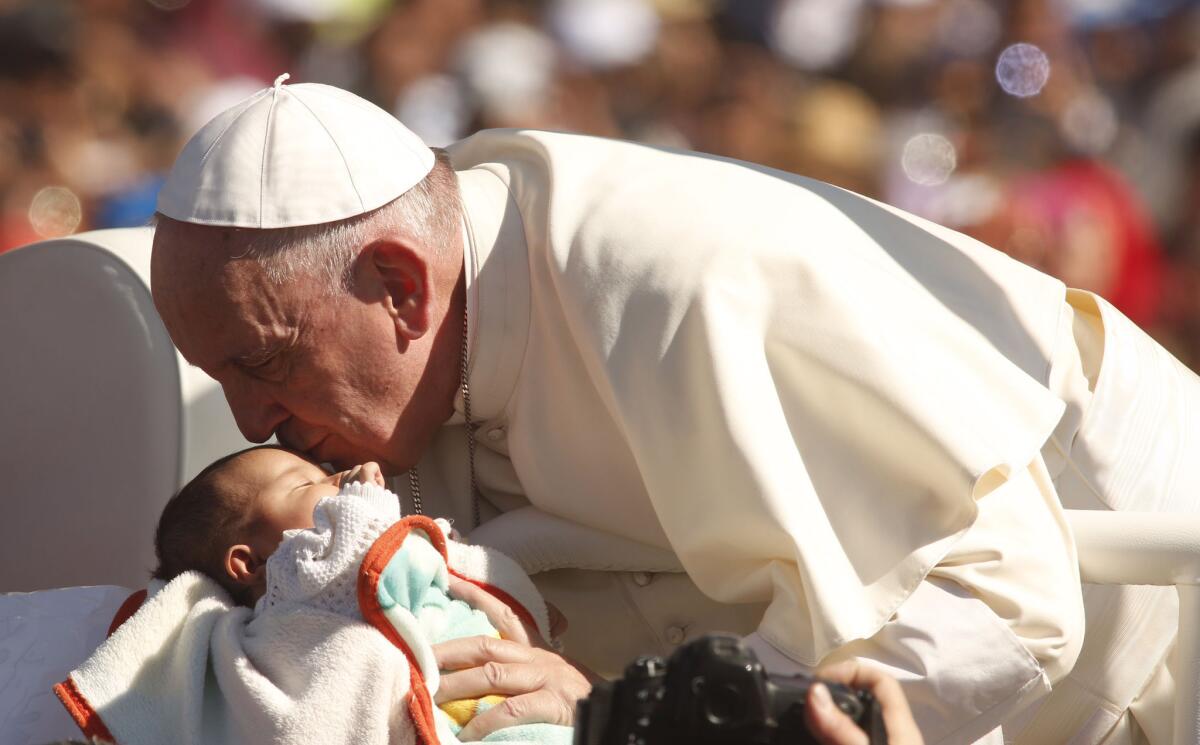
Pope Francis kisses a baby while riding through a crowd of pilgrims, many from indigenous communities surrounding San Cristobal de las Casas. The Mass included several Mayan languages.
One choral group came from the town of San Juan Larrainzar, which was a stronghold of the Zapatista rebellion, an armed uprising that sought to improve indigenous rights. The town was also the site of talks between government officials and Zapatista representatives that resulted in the so-called San Andres accords of 1996, which promised greater rights for Mexico’s indigenous population.
Critics say successive Mexican governments have done little to improve the status of the nation’s indigenous people, long plagued by poverty and social marginalization. Indigenous residents interviewed here in recent days say improvements have been negligible in the past two decades.
“In truth, things haven’t gotten better for us since 1996,” said Manuel Perez Teratol, 49, who was part of the San Andres Larrainzar choral group at the event. “The accords were basically useless.”
All of the choral members were dressed in traditional wool ponchos, sandals, and straw hats with multicolored ribbons.
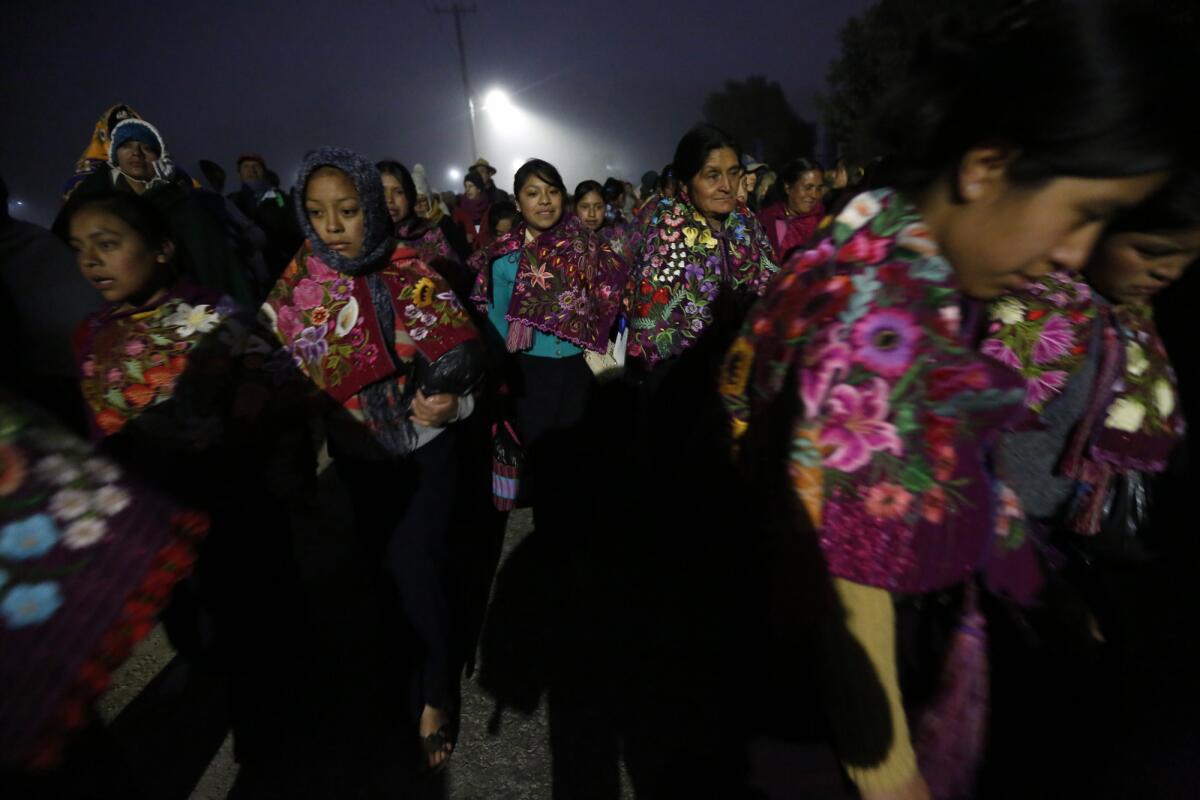
Indigenous pilgrims from villages surrounding the southern Mexican town of San Cristobal de las Casas walk to the Municipal Sports Center, where Pope Francis conducted Mass.
Another choral member, Jose Diaz Ruiz, 27, who was a child when the Zapatista rebellion broke out, said many from San Andres Larrainzar contemplate leaving the close-knit community because of the lack of job opportunities.
“Sometimes people think of going somewhere else, even to the United States, because there is no hope,” said Diaz Ruiz. “But all of our families and traditions are here. And we are afraid of losing this.”
Also among the players at the mass was an almost 100-member ensemble from the state of Oaxaca, most dressed in indigenous-style white outfits and ponchos. The group goes by an elaborate title: the Municipal Musical Band of Santa Maria Tepantlali Mixe, Oaxaca.
The band played several pieces from a traditional Oaxacan Mass. The band is heavy on brass — trumpets, tubas, French horns, trombones — but also features saxophones, clarinets and drums, among other instruments.
“It’s a privilege to be here,” said the band’s director, Alfredo Reyes Juarez, who noted that an earlier generation of the ensemble had played during a 1979 visit to Oaxaca by the late Pope Juan Paul II. “Francisco seems to be a man of the people. That’s why there is so much emotion.”
The day had begun with the streets of this colonial town filled with tens of thousands assembled to hear the pope’s message.
The line outside the stadium stretched for miles, winding through streets where vendors sold atole de arroz, a hot rice drink, along with coffee, hot chocolate, tamales and tortas. And, of course, there were the now-familiar entrepreneurs hawking pope calendars, flags, T-shirts and other pontiff paraphernalia.
Veronica Lopez Perez, 62, brought with her a green, handcrafted wooden cross she hoped the pope would bless. She, her brother and her mother all came from San Juan Chamula, just outside San Cristobal. The green cross had an image of her village’s colonial-era church emblazoned on the front.
“We heard he is a good man — he cares for the poor,” said her brother, Ricardo Lopez Perez, 39, who wore a broad-brimmed straw hat, a white sheepskin vest and polished cowboy boots. “We never thought the pope would come to see us here.”
After the mass, the pontiff left the stadium in his popemobile to thunderous cheers, and his entourage made its way through San Cristobal de las Casas, beneath a strong mid-day sun.
“Viva el Papa de los pobres!” — “Long live the pope of the poor!” — was one of many chants.
Throngs of well-wishers gathered behind barricades erected along the two-mile route. Many waved Vatican flags and images of the pope.
Francisco had lunch with indigenous community leaders and, later, visited the cathedral, where he addressed a select group of about 1,200 guests, including many disabled people and elderly.
Also at the cathedral, the pope visited and said a brief prayer at the tomb of San Cristobal’s late bishop, Samuel Ruiz, who was much beloved among Chiapas’ indigenous population. Ruiz’s pastoral work with the poor has apparently impressed Francis, who has also emphasized the church’s role in helping the less fortunate.
During his lifetime, Ruiz often ran afoul of church authorities and local politicians, who accused him of practicing Marxist-oriented “liberation theology” and politicizing religion.
Many catechists and deacons trained under Ruiz reportedly joined the 1994 Zapatista rebellion. Later, Ruiz was a key mediator in talks between the government and the Zapatista rebels.
Many of those invited to the afternoon event in the cathedral were disabled. People in wheelchairs and on crutches were among those waiting.
“This is like a dream for me,” said Maria Magdalena Muñoz Robledo, 49, from the city of Comitan de las Flores, who was among those waiting outside the cathedral. “Francisco is a man of the people, like St. Francis of Assisi.”
She wore a double rebozo, or shawl, one yellow and one white — the colors of the Vatican — along with a straw hat, protection from the sun that would break through later in the morning.
“We have to wait, but who cares? It’s worth it.”
After leaving San Cristobal, Francis met with four families in a packed stadium in Tuxtla Gutierrez, the capital of Chiapas state. All faced different challenges in meshing their personal lives with their faith.
One couple, Humberto Gomez Espinoza and Claudia Castillo Leal, said they married 16 years ago in a civil ceremony and now have an 11-year-old son. Because she was previously divorced, they explained, they could not have a church wedding and still cannot partake in Holy Communion.
“We cannot access the Eucharist, but … we look for a way to transmit the love of God by helping addicts in a prison,” Gomez Espinoza said.
Francis rose from his chair and embraced the couple. He praised their charity work and dedication, but didn’t offer any hope that the church’s teachings on divorce would change any time soon.
“You pray, you are integrated with Jesus, you are in the church and take communion with the brother in need, the weak brother,” the pope said. “Thank you.”
The pope returned to Mexico City to prepare for Tuesday’s journey to the state of Michoacan.
Special correspondents Cecilia Sanchez in Mexico City and Liliana Nieto del Rio in San Cristobal de las Casas contributed to this report
Follow @mcdneville and @TracyKWilkinson on Twitter.
MORE ON POPE FRANCIS
Migrant voices: On journey to north, ‘you can’t smile because there is no reason to’
Pope Francis, visiting a bastion of poverty, envisions Mexico as a land of opportunity
Meet the deportee who fashioned the altar for Pope Francis’ cross-border Mass
More to Read
Start your day right
Sign up for Essential California for news, features and recommendations from the L.A. Times and beyond in your inbox six days a week.
You may occasionally receive promotional content from the Los Angeles Times.

